Dissertation surveys: Questions, examples, and best practices
Collect data for your dissertation with little effort and great results.
Dissertation surveys are one of the most powerful tools to get valuable insights and data for the culmination of your research. However, it’s one of the most stressful and time-consuming tasks you need to do. You want useful data from a representative sample that you can analyze and present as part of your dissertation. At SurveyPlanet, we’re committed to making it as easy and stress-free as possible to get the most out of your study.
With an intuitive and user-friendly design, our templates and premade questions can be your allies while creating a survey for your dissertation. Explore all the options we offer by simply signing up for an account—and leave the stress behind.

How to write dissertation survey questions
The first thing to do is to figure out which group of people is relevant for your study. When you know that, you’ll also be able to adjust the survey and write questions that will get the best results.
The next step is to write down the goal of your research and define it properly. Online surveys are one of the best and most inexpensive ways to reach respondents and achieve your goal.
Before writing any questions, think about how you’ll analyze the results. You don’t want to write and distribute a survey without keeping how to report your findings in mind. When your thesis questionnaire is out in the real world, it’s too late to conclude that the data you’re collecting might not be any good for assessment. Because of that, you need to create questions with analysis in mind.
You may find our five survey analysis tips for better insights helpful. We recommend reading it before analyzing your results.
Once you understand the parameters of your representative sample, goals, and analysis methodology, then it’s time to think about distribution. Survey distribution may feel like a headache, but you’ll find that many people will gladly participate.
Find communities where your targeted group hangs out and share the link to your survey with them. If you’re not sure how large your research sample should be, gauge it easily with the survey sample size calculator.
Need help with writing survey questions? Read our guide on well-written examples of good survey questions .
Dissertation survey examples
Whatever field you’re studying, we’re sure the following questions will prove useful when crafting your own.
At the beginning of every questionnaire, inform respondents of your topic and provide a consent form. After that, start with questions like:
- Please select your gender:
- What is the highest educational level you’ve completed?
- High school
- Bachelor degree
- Master’s degree
- On a scale of 1-7, how satisfied are you with your current job?
- Please rate the following statements:
- I always wait for people to text me first.
- Strongly Disagree
- Neither agree nor disagree
- Strongly agree
- My friends always complain that I never invite them anywhere.
- I prefer spending time alone.
- Rank which personality traits are most important when choosing a partner. Rank 1 - 7, where 1 is the most and 7 is the least important.
- Flexibility
- Independence
- How openly do you share feelings with your partner?
- Almost never
- Almost always
- In the last two weeks, how often did you experience headaches?
Dissertation survey best practices
There are a lot of DOs and DON’Ts you should keep in mind when conducting any survey, especially for your dissertation. To get valuable data from your targeted sample, follow these best practices:
Use the consent form.
The consent form is a must when distributing a research questionnaire. A respondent has to know how you’ll use their answers and that the survey is anonymous.
Avoid leading and double-barreled questions
Leading and double-barreled questions will produce inconclusive results—and you don’t want that. A question such as: “Do you like to watch TV and play video games?” is double-barreled because it has two variables.
On the other hand, leading questions such as “On a scale from 1-10 how would you rate the amazing experience with our customer support?” influence respondents to answer in a certain way, which produces biased results.
Use easy and straightforward language and questions
Don’t use terms and professional jargon that respondents won’t understand. Take into consideration their educational level and demographic traits and use easy-to-understand language when writing questions.
Mix close-ended and open-ended questions
Too many open-ended questions will annoy respondents. Also, analyzing the responses is harder. Use more close-ended questions for the best results and only a few open-ended ones.
Strategically use different types of responses
Likert scale, multiple-choice, and ranking are all types of responses you can use to collect data. But some response types suit some questions better. Make sure to strategically fit questions with response types.
Ensure that data privacy is a priority
Make sure to use an online survey tool that has SSL encryption and secure data processing. You don’t want to risk all your hard work going to waste because of poorly managed data security. Ensure that you only collect data that’s relevant to your dissertation survey and leave out any questions (such as name) that can identify the respondents.
Create dissertation questionnaires with SurveyPlanet
Overall, survey methodology is a great way to find research participants for your research study. You have all the tools required for creating a survey for a dissertation with SurveyPlanet—you only need to sign up . With powerful features like question branching, custom formatting, multiple languages, image choice questions, and easy export you will find everything needed to create, distribute, and analyze a dissertation survey.
Happy data gathering!
Sign up now
Free unlimited surveys, questions and responses.
Dissertation & Thesis Survey Design 101
5 Common Mistakes To Avoid (+ Examples)
By: David Phair (PhD) & Kerryn Warren (PhD) | April 2022
Surveys are a powerful way to collect data for your dissertation, thesis or research project. Done right, a good survey allows you to collect large swathes of useful data with (relatively) little effort. However, if not designed well, you can run into serious issues.
Over the years, we’ve encountered numerous common mistakes students make when it comes to survey design. In this post, we’ll unpack five of these costly mistakes.
Overview: 5 Survey Design Mistakes
- Having poor overall survey structure and flow
- Using poorly constructed questions and/or statements
- Implementing inappropriate response types
- Using unreliable and/or invalid scales and measures
- Designing without consideration for analysis techniques
Mistake #1: Having poor structure and flow
One of the most common issues we see is poor overall survey structure and flow . If a survey is designed badly, it will discourage participants from completing it. As a result, few participants will take the time to respond to the survey, which can lead to a small sample size and poor or even unusable results . Let’s look at a few best practices to ensure good overall structure and flow.
1. Make sure your survey is aligned with your study’s “golden thread”.
The first step might seem obvious, but it’s important to develop survey questions that are tightly aligned with your research question(s), aims and objectives – in other words, “your golden thread”. Your survey serves to generate the data that will answer these key ideas in your thesis; if it doesn’t do that, you’ve got a serious problem. To put it simply, it’s critically important to design your survey questions with the golden thread of your study front of mind at all times.
2. Order your questions in an intuitive, logical way.
The types of questions you ask and when you ask them are vital aspects when designing an effective survey. To avoid losing respondents, you need to order your questions clearly and logically.
In general, it’s a good idea to ask exclusion questions upfront . For example, if your research is focused on an aspect of women’s lives, your first question should be one to determine the gender of the respondent (and filter out unsuitable respondents). Once that’s out of the way, the exclusion questions can be followed by questions related to the key constructs or ideas and/or the dependent and independent variables in your study.
Lastly, the demographics-related questions are usually positioned at the end of the survey. These are questions related to the characteristics of your respondents (e.g., age, race, occupation). It’s a good idea to position these questions at the end of your survey because respondents can get caught up in these identity-related questions as they move through the rest of your survey. Placing them at the end of your survey helps ensure that the questions related to the core constructs of your study will have the respondents’ full attention.

3. Design for user experience and ease of use.
This might seem obvious, but it’s essential to carefully consider your respondents’ “journey” when designing your survey. In other words, you need to keep user experience and engagement front of mind when designing your survey.
One way of creating a good user experience is to have a clear introduction or cover page upfront. On this intro page, it’s good to communicate the estimated time required to complete the survey (generally, 15 to 20 minutes is reasonable). Also, make u se of headings and short explainers to help respondents understand the context of each question or section in your survey. It’s also helpful if you provide a progress indicator to indicate how far they are in completing the survey.
Naturally, readability is important to a successful survey. So, keep the survey content as concise as possible, as people tend to drop out of long surveys. A general rule of thumb is to make use of plain, easy-to-understand language . Related to this, always carefully edit and proofread your survey before launching it. Typos, grammar and formatting issues will heavily detract from the credibility of your work and will likely increase respondent dropout.
In cases where you have no choice but to use a technical term or industry jargon, be sure to explain the meaning (define the term) first. You don’t want respondents to be distracted or confused by the technical aspects of your survey. In addition to this, create a logical flow by grouping related topics together and moving from general to more specific questions.
You should also think about what devices respondents will use to access your survey. Because many people use their phones to complete your survey, making it mobile-friendly means more people will be able to respond, which is hugely beneficial. By hosting your survey on a trusted provider (e.g., SurveyMonkey or Qualtrix), the mobile aspect should be taken care of, but always test your survey on a few devices. Aside from making the data collection easier, using a well-established survey platform will also make processing your survey data easier.
4. Prioritise ethics and data privacy.
The last (and very important) point to consider when designing your survey is the ethical requirements. Your survey design must adhere to all ethics policies and data protection laws of your country. If you (or your respondents) are in Europe for instance, you’ll need to comply with GDPR. It’s also essential to highlight to your respondents that all data collected will be handled and stored securely , to minimise any concerns about the confidentiality and safety of their data.

Mistake #2: Using poorly constructed questions
Another common survey design issue we encounter is poorly constructed questions and statements. There are a few ways in which questions can be poorly constructed. These usually fall into four broad categories:
- Loaded questions
- Leading questions
- Double-barreled questions
- Vague questions
Let’s look at each of these.
A loaded question assumes something about the respondent without having any data to support that assumption. For example, if the question asks, “Where is your favourite place to eat steak?”, it assumes that the respondent eats steak. Clearly, this is problematic for respondents that are vegetarians or vegans, or people that simply don’t like steak.
A leading question pushes the respondent to answer in a certain way. For example, a question such as, “How would you rate the excellent service at our restaurant?” is trying to influence the way that the respondent thinks about the service at the restaurant. This can be annoying to the respondent (at best) or lead them to respond in a way they wouldn’t have, had the question been more objective.
Need a helping hand?
A double-barreled question is a question that contains two (or more) variables within it. It essentially tries to ask two questions at the same time. An example of this is
“ Do you enjoy eating peanut butter and cheese on bread?”
As you can see, this question makes it unclear whether you are being asked about whether they like eating the two together on bread, or whether they like eating one at a time. This is problematic, as there are multiple ways to interpret this question, which means that the resultant data will be unusable.
A vague question , as the name suggests, is one where it is unclear what is being asked or one that is very open-ended . Of course, sometimes you do indeed want open questions, as they can provide richer information from respondents. However, if you ask a vague question, you’ll likely get a vague answer. So, you need to be careful. Consider the following fairly vague question:
“What was your experience at this restaurant?”.
A respondent could answer this question by just saying “good” or “bad” – or nothing at all. This isn’t particularly helpful. Alternatively, someone might respond extensively about something unrelated to the question. If you want to ask open-ended questions, interviewing may be a better (or additional) data method to consider, so give some thought to what you’re trying to achieve. Only use open-ended questions in a survey if they’re central to your research aims .
To make sure that your questions don’t fall into one of these problematic categories, it’s important to keep your golden thread (i.e., your research aims, objectives and research questions ) in mind and consider the type of data you want to generate. Also, it’s always a good idea to make use of a pilot study to test your survey questions and responses to see whether any questions are problematic and whether the data generated is useful.

Mistake #3: Using inappropriate response types
When designing your survey, it’s essential to choose the best-suited response type/format for each question. In other words, you need to consider how the respondents will input their responses into your survey. Broadly speaking, there are three response types .
The first response type is categorical.
These are questions where the respondent will choose one of the pre-determined options that you provide, for example: yes/no, gender, ethnicity, etc.
For categorical responses, there will be a limited number of choices and respondents will only be able to pick one. This is useful for basic demographic data where all potential responses can be easily grouped into categories.
The second response type is scales .
Scales offer respondents the opportunity to express their opinion on a spectrum . For example, you could design a 3-point scale with the options of agree, neutral and disagree. Scales are useful when you’re trying to assess the extent to which respondents agree with specific statements or claims. This data can then be statistically analysed in powerful ways.
Scales can, however, be problematic if they have too many or too few points . For example, if you only have “strongly agree”, “neutral” and “strongly disagree”, your respondent might resort to selecting “neutral” because they don’t feel strongly about the subject. Conversely, if there are too many points on the scale, your respondents might take too much time to complete the survey and become frustrated in the process of agonising over what exactly they feel.
The third response type is the free form text box (open-ended response).
We mentioned open-ended questions earlier and looked at some of the ways in which they can be problematic. But, because free-form responses are useful for understanding nuances and finer details, this response type does have its benefits. For example, some respondents might have a problem with how the other questions in your survey are presented or asked, and therefore an open-ended response option gives them an opportunity to respond in a way that reflects their true feelings.
As you can see, it’s important to carefully consider which response types you use, as each one has its own purpose, pros and cons . Make sure that each response option is appropriate for the type of question and generates data that you will be able to analyse in a meaningful way.
It’s also good to keep in mind that you as the researcher will need to process all the data generated by the survey. Therefore, you need to consider how you will analyse the data from each response type. Use the response type that makes sense for the specific question and keep the analysis aspect in mind when choosing your response types.

Mistake #4: Using poorly design scales/measures
We’ve spoken about the design of the survey as a whole, but it’s also important to think carefully about the design of individual measures/scales. Theoretical constructs are typically measured using Likert scales. To measure these constructs effectively, you’ll need to ensure that your scales produce valid and reliable data.
Validity refers to whether the scale measures what you’re trying to measure . This might sound like a no-brainer, but oftentimes people can interpret questions or statements in diverse ways. Therefore, it’s important to think of whether the interpretations of the responses to each measure are sound relative to the original construct you are measuring and the existing literature relating to it.
Reliability, on the other hand, is related to whether multiple scales measuring the same construct get the same response (on average, of course). In other words, if you have three scales measuring employee satisfaction, they should correlate, as they all measure the same construct. A good survey should make use of multiple scales to measure any given construct, and these should “move” together – in other words, be “reliable”.
If you’re designing a survey, you’ll need to demonstrate the validity and reliability of your measures. This can be done in several ways, using both statistical and non-statistical techniques. We won’t get into detail about those here, but it’s important to remember that validity and reliability are central to making sure that your survey is measuring what it is meant to measure.
Importantly, when thinking about the scales for your survey, you don’t need to reinvent the wheel. There are pre-developed and tested scales available for most areas of research, and it’s preferable to use a “tried and tested” scale, rather than developing one from scratch. If there isn’t already something that fits your research, you can often modify existing scales to suit your specific needs.

Mistake #5: Not designing with analysis in mind
Naturally, you’ll want to use the data gathered from your survey as effectively as possible. Therefore, it’s always a good idea to start with the end (i.e., the analysis phase) in mind when designing your survey. The analysis methods that you’ll be able to use in your study will be dictated by the design of the survey, as it will produce certain types of data. Therefore, it’s essential that you design your survey in a way that will allow you to undertake the analyses you need to achieve your research aims.
Importantly, you should have a clear idea of what statistical methods you plan to use before you start designing your survey. Be clear about which specific descriptive and inferential tests you plan to do (and why). Make sure that you understand the assumptions of all the statistical tests you’ll be using and the type of data (i.e., nominal, ordinal, interval, or ratio ) that each test requires. Only once you have that level of clarity can you get started designing your survey.
Finally, and as we’ve emphasized before, it’s essential that you keep your study’s golden thread front of mind during the design process. If your analysis methods don’t aid you in answering your research questions, they’ll be largely useless. So, keep the big picture and the end goal front of mind from the outset.
Recap: Survey Design Mistakes
In this post we’ve discussed some important aspects of survey design and five common mistakes to avoid while designing your own survey. To recap, these include:
If you have any questions about these survey design mistakes, drop a comment below. Alternatively, if you’re interested in getting 1-on-1 help with your research , check out our dissertation coaching service or book a free initial consultation with a friendly coach.

Psst... there’s more!
This post was based on one of our popular Research Bootcamps . If you're working on a research project, you'll definitely want to check this out ...
You Might Also Like:

Thank you much for this article. I really appreciate it.
Please do you handle someone’s project write up or you can guide someone through out the project write up?
Very useful and understandable for a user like me. I thank you very much !!
Submit a Comment Cancel reply
Your email address will not be published. Required fields are marked *
Save my name, email, and website in this browser for the next time I comment.
- Print Friendly
Masters Compare - Find your perfect masters course.

- Studying a Postgraduate degree
Your postgraduate student guide to using a research questionnaire for your dissertation
Share this article.
- Facebook Sharer
- Twitter Sharer
- LinkedIn Sharer

Explore other topics
- Funding a Postgraduate course
- Living as a Postgraduate student
- Popular masters degree subjects
- Student Wellbeing
- Finding a PhD or Masters Course
Think Postgrad
Frequently asked questions.
There are a few key steps in creating a dissertation for use in your thesis. Firstly, you should think about the topic you are studying and who you need to respond to your questionnaire. You then need to think about how you can deliver the questions, this can be in the form of in-person interviews or emails. You can begin to formulate your questions and format.
Visit the Studying for a PhD section for more information and advice.
Prof Martyn Denscombe, author of “ The Good Research Guide, 6th edition ”, gives expert advice on using a questionnaire survey for your postgraduate dissertation.
Questionnaire surveys are a well-established way of collecting data. They can be used with relatively small-scale research projects, and research questionnaires can be designed and delivered quite quickly and cheaply. It is not surprising, therefore, that when it comes to conducting research for a master’s dissertation, questionnaire surveys feature prominently as the research method of choice.
Occasionally such thesis surveys will be sent out by post, and sometimes the questionnaires will be distributed by hand. But the popularity of questionnaire surveys in the context of master’s dissertations is principally due to the benefits of using online web-based questionnaires. There are two main aspects to this.
First, the software for producing and delivering web questionnaires, with their features such as drop-down menus and tick-box answers, is user-friendly and inexpensive.
Second, online surveys make it possible to contact people across the globe without travelling anywhere which, given the time and resource constraints faced when producing a dissertation, makes online surveys all the more enticing. (And, for the more adventurous students, there are also developing possibilities for the use of social media such as Facebook and SMS texts for contacting people to participate in the survey.)
In the context of a master’s dissertation, however, the quality of the survey data is a vital issue. The grade for the dissertation will depend on being able to defend the use of the data from the survey as the basis for advanced, master’s level academic enquiry. Which means it is not good enough to simply rely on getting 100 or so people to complete your questionnaire. Students are expected to be aware of the pros and cons of questionnaire surveys and to be able to justify the value of the data they have collected in the face of probing questions such as:
- Who are the respondents and how they were selected?
- How representative are the respondents of the whole group being studied?
- What response rate was achieved by the survey?
- Are the questions suitable in relation to the topic and the particular respondents?
- What likelihood is there that respondents gave honest answers to the questions?
This is where The Good Research Guide, 6th edition becomes so valuable.
It not only identifies the key points that need to be addressed in order to conduct a competent questionnaire survey, it gets right to the heart of the matter with plenty of practical guidance on how to deal with the issues. In a straightforward style, using plain language, this bestselling book covers a range of alternative strategies and methods for conducting small-scale social research projects and outlines some of the main ways in which the data can be analysed.
Read Prof Martyn Denscombe’s advice on using a Case Study for your postgraduate dissertation
- Advertisers
- Cookie Policy
- Terms and Conditions
Sorry! You need to sign up
Sign up to Postgraduate Studentships
Sign up to compare masters
Opportunity added!
Thanks for making your selection. Click below to view your list.
Course Added
Thanks for making your selection. Click below to view your comparisons.

Think Postgrad Ltd 2008-2024 Website By Parachute
- Utility Menu
Harvard University Program on Survey Research
- Questionnaire Design Tip Sheet
This PSR Tip Sheet provides some basic tips about how to write good survey questions and design a good survey questionnaire.
PSR Resources
- Managing and Manipulating Survey Data: A Beginners Guide
- Finding and Hiring Survey Contractors
- How to Frame and Explain the Survey Data Used in a Thesis
- Overview of Cognitive Testing and Questionnaire Evaluation
- Sampling, Coverage, and Nonresponse Tip Sheet
- Introduction to Surveys for Honors Thesis Writers
- PSR Introduction to the Survey Process
- Related Centers/Programs at Harvard
- General Survey Reference
- Institutional Review Boards
- Select Funding Opportunities
- Survey Analysis Software
- Professional Standards
- Professional Organizations
- Major Public Polls
- Survey Data Collections
- Major Longitudinal Surveys
- Other Links

Want to create or adapt books like this? Learn more about how Pressbooks supports open publishing practices.
13.1 Writing effective survey questions and questionnaires
Learning objectives.
Learners will be able to…
- Describe some of the ways that survey questions might confuse respondents and how to word questions and responses clearly
- Create mutually exclusive, exhaustive, and balanced response options
- Define fence-sitting and floating
- Describe the considerations involved in constructing a well-designed questionnaire
- Discuss why pilot testing is important
In the previous chapter, we reviewed how researchers collect data using surveys. Guided by their sampling approach and research context, researchers should choose the survey approach that provides the most favorable tradeoffs in strengths and challenges. With this information in hand, researchers need to write their questionnaire and revise it before beginning data collection. Each method of delivery requires a questionnaire, but they vary a bit based on how they will be used by the researcher. Since phone surveys are read aloud, researchers will pay more attention to how the questionnaire sounds than how it looks. Online surveys can use advanced tools to require the completion of certain questions, present interactive questions and answers, and otherwise afford greater flexibility in how questionnaires are designed. As you read this chapter, consider how your method of delivery impacts the type of questionnaire you will design.

Start with operationalization
The first thing you need to do to write effective survey questions is identify what exactly you wish to know. As silly as it sounds to state what seems so completely obvious, we can’t stress enough how easy it is to forget to include important questions when designing a survey. Begin by looking at your research question and refreshing your memory of the operational definitions you developed for those variables from Chapter 11. You should have a pretty firm grasp of your operational definitions before starting the process of questionnaire design. You may have taken those operational definitions from other researchers’ methods, found established scales and indices for your measures, or created your own questions and answer options.
TRACK 1 (IF YOU ARE CREATING A RESEARCH PROPOSAL FOR THIS CLASS)
STOP! Make sure you have a complete operational definition for the dependent and independent variables in your research question. A complete operational definition contains the variable being measured, the measure used, and how the researcher interprets the measure. Let’s make sure you have what you need from Chapter 11 to begin writing your questionnaire.
List all of the dependent and independent variables in your research question.
- It’s normal to have one dependent or independent variable. It’s also normal to have more than one of either.
- Make sure that your research question (and this list) contain all of the variables in your hypothesis. Your hypothesis should only include variables from you research question.
For each variable in your list:
- If you don’t have questions and answers finalized yet, write a first draft and revise it based on what you read in this section.
- If you are using a measure from another researcher, you should be able to write out all of the questions and answers associated with that measure. If you only have the name of a scale or a few questions, you need to access to the full text and some documentation on how to administer and interpret it before you can finish your questionnaire.
- For example, an interpretation might be “there are five 7-point Likert scale questions…point values are added across all five items for each participant…and scores below 10 indicate the participant has low self-esteem”
- Don’t introduce other variables into the mix here. All we are concerned with is how you will measure each variable by itself. The connection between variables is done using statistical tests, not operational definitions.
- Detail any validity or reliability issues uncovered by previous researchers using the same measures. If you have concerns about validity and reliability, note them, as well.
TRACK 2 (IF YOU AREN’T CREATING A RESEARCH PROPOSAL FOR THIS CLASS)
You are interested in researching the decision-making processes of parents of elementary-aged children during the beginning of the COVID-19 pandemic in 2020. Specifically, you want to if and how parents’ socioeconomic class impacted their decisions about whether to send their children to school in-person or instead opt for online classes or homeschooling.
- Create a working research question for this topic.
- What is the dependent variable in this research question? The independent variable? What other variables might you want to control?
For the independent variable, dependent variable, and at least one control variable from your list:
- What measure (the specific question and answers) might you use for each one? Write out a first draft based on what you read in this section.
If you completed the exercise above and listed out all of the questions and answer choices you will use to measure the variables in your research question, you have already produced a pretty solid first draft of your questionnaire! Congrats! In essence, questionnaires are all of the self-report measures in your operational definitions for the independent, dependent, and control variables in your study arranged into one document and administered to participants. There are a few questions on a questionnaire (like name or ID#) that are not associated with the measurement of variables. These are the exception, and it’s useful to think of a questionnaire as a list of measures for variables. Of course, researchers often use more than one measure of a variable (i.e., triangulation ) so they can more confidently assert that their findings are true. A questionnaire should contain all of the measures researchers plan to collect about their variables by asking participants to self-report.
Sticking close to your operational definitions is important because it helps you avoid an everything-but-the-kitchen-sink approach that includes every possible question that occurs to you. Doing so puts an unnecessary burden on your survey respondents. Remember that you have asked your participants to give you their time and attention and to take care in responding to your questions; show them your respect by only asking questions that you actually plan to use in your analysis. For each question in your questionnaire, ask yourself how this question measures a variable in your study. An operational definition should contain the questions, response options, and how the researcher will draw conclusions about the variable based on participants’ responses.

Writing questions
So, almost all of the questions on a questionnaire are measuring some variable. For many variables, researchers will create their own questions rather than using one from another researcher. This section will provide some tips on how to create good questions to accurately measure variables in your study. First, questions should be as clear and to the point as possible. This is not the time to show off your creative writing skills; a survey is a technical instrument and should be written in a way that is as direct and concise as possible. As I’ve mentioned earlier, your survey respondents have agreed to give their time and attention to your survey. The best way to show your appreciation for their time is to not waste it. Ensuring that your questions are clear and concise will go a long way toward showing your respondents the gratitude they deserve. Pilot testing the questionnaire with friends or colleagues can help identify these issues. This process is commonly called pretesting, but to avoid any confusion with pretesting in experimental design, we refer to it as pilot testing.
Related to the point about not wasting respondents’ time, make sure that every question you pose will be relevant to every person you ask to complete it. This means two things: first, that respondents have knowledge about whatever topic you are asking them about, and second, that respondents have experienced the events, behaviors, or feelings you are asking them to report. If you are asking participants for second-hand knowledge—asking clinicians about clients’ feelings, asking teachers about students’ feelings, and so forth—you may want to clarify that the variable you are asking about is the key informant’s perception of what is happening in the target population. A well-planned sampling approach ensures that participants are the most knowledgeable population to complete your survey.
If you decide that you do wish to include questions about matters with which only a portion of respondents will have had experience, make sure you know why you are doing so. For example, if you are asking about MSW student study patterns, and you decide to include a question on studying for the social work licensing exam, you may only have a small subset of participants who have begun studying for the graduate exam or took the bachelor’s-level exam. If you decide to include this question that speaks to a minority of participants’ experiences, think about why you are including it. Are you interested in how studying for class and studying for licensure differ? Are you trying to triangulate study skills measures? Researchers should carefully consider whether questions relevant to only a subset of participants is likely to produce enough valid responses for quantitative analysis.
Many times, questions that are relevant to a subsample of participants are conditional on an answer to a previous question. A participant might select that they rent their home, and as a result, you might ask whether they carry renter’s insurance. That question is not relevant to homeowners, so it would be wise not to ask them to respond to it. In that case, the question of whether someone rents or owns their home is a filter question , designed to identify some subset of survey respondents who are asked additional questions that are not relevant to the entire sample. Figure 13.1 presents an example of how to accomplish this on a paper survey by adding instructions to the participant that indicate what question to proceed to next based on their response to the first one. Using online survey tools, researchers can use filter questions to only present relevant questions to participants.

Researchers should eliminate questions that ask about things participants don’t know to minimize confusion. Assuming the question is relevant to the participant, other sources of confusion come from how the question is worded. The use of negative wording can be a source of potential confusion. Taking the question from Figure 13.1 about drinking as our example, what if we had instead asked, “Did you not abstain from drinking during your first semester of college?” This is a double negative, and it’s not clear how to answer the question accurately. It is a good idea to avoid negative phrasing, when possible. For example, “did you not drink alcohol during your first semester of college?” is less clear than “did you drink alcohol your first semester of college?”
Another 877777771`issue arises when you use jargon, or technical language, that people do not commonly know. For example, if you asked adolescents how they experience imaginary audience , they would find it difficult to link those words to the concepts from David Elkind’s theory. The words you use in your questions must be understandable to your participants. If you find yourself using jargon or slang, break it down into terms that are more universal and easier to understand.
Asking multiple questions as though they are a single question can also confuse survey respondents. There’s a specific term for this sort of question; it is called a double-barreled question . Figure 13.2 shows a double-barreled question. Do you see what makes the question double-barreled? How would someone respond if they felt their college classes were more demanding but also more boring than their high school classes? Or less demanding but more interesting? Because the question combines “demanding” and “interesting,” there is no way to respond yes to one criterion but no to the other.

Another thing to avoid when constructing survey questions is the problem of social desirability . We all want to look good, right? And we all probably know the politically correct response to a variety of questions whether we agree with the politically correct response or not. In survey research, social desirability refers to the idea that respondents will try to answer questions in a way that will present them in a favorable light. (You may recall we covered social desirability bias in Chapter 11. )
Perhaps we decide that to understand the transition to college, we need to know whether respondents ever cheated on an exam in high school or college for our research project. We all know that cheating on exams is generally frowned upon (at least I hope we all know this). So, it may be difficult to get people to admit to cheating on a survey. But if you can guarantee respondents’ confidentiality, or even better, their anonymity, chances are much better that they will be honest about having engaged in this socially undesirable behavior. Another way to avoid problems of social desirability is to try to phrase difficult questions in the most benign way possible. Earl Babbie (2010) [1] offers a useful suggestion for helping you do this—simply imagine how you would feel responding to your survey questions. If you would be uncomfortable, chances are others would as well.
Try to step outside your role as researcher for a second, and imagine you were one of your participants. Evaluate the following:
- Is the question too general? Sometimes, questions that are too general may not accurately convey respondents’ perceptions. If you asked someone how they liked a certain book and provide a response scale ranging from “not at all” to “extremely well”, and if that person selected “extremely well,” what do they mean? Instead, ask more specific behavioral questions, such as “Will you recommend this book to others?” or “Do you plan to read other books by the same author?”
- Is the question too detailed? Avoid unnecessarily detailed questions that serve no specific research purpose. For instance, do you need the age of each child in a household or is just the number of children in the household acceptable? However, if unsure, it is better to err on the side of details than generality.
- Is the question presumptuous? Does your question make assumptions? For instance, if you ask, “what do you think the benefits of a tax cut would be?” you are presuming that the participant sees the tax cut as beneficial. But many people may not view tax cuts as beneficial. Some might see tax cuts as a precursor to less funding for public schools and fewer public services such as police, ambulance, and fire department. Avoid questions with built-in presumptions.
- Does the question ask the participant to imagine something? Is the question imaginary? A popular question on many television game shows is “if you won a million dollars on this show, how will you plan to spend it?” Most participants have never been faced with this large amount of money and have never thought about this scenario. In fact, most don’t even know that after taxes, the value of the million dollars will be greatly reduced. In addition, some game shows spread the amount over a 20-year period. Without understanding this “imaginary” situation, participants may not have the background information necessary to provide a meaningful response.
Try to step outside your role as researcher for a second, and imagine you were one of your participants. Use the following prompts to evaluate your draft questions from the previous exercise:
Cultural considerations
When researchers write items for questionnaires, they must be conscientious to avoid culturally biased questions that may be inappropriate or difficult for certain populations.
[insert information related to asking about demographics and how this might make some people uncomfortable based on their identity(ies) and how to potentially address]
You should also avoid using terms or phrases that may be regionally or culturally specific (unless you are absolutely certain all your respondents come from the region or culture whose terms you are using). When I first moved to southwest Virginia, I didn’t know what a holler was. Where I grew up in New Jersey, to holler means to yell. Even then, in New Jersey, we shouted and screamed, but we didn’t holler much. In southwest Virginia, my home at the time, a holler also means a small valley in between the mountains. If I used holler in that way on my survey, people who live near me may understand, but almost everyone else would be totally confused.
Testing questionnaires before using them
Finally, it is important to get feedback on your survey questions from as many people as possible, especially people who are like those in your sample. Now is not the time to be shy. Ask your friends for help, ask your mentors for feedback, ask your family to take a look at your survey as well. The more feedback you can get on your survey questions, the better the chances that you will come up with a set of questions that are understandable to a wide variety of people and, most importantly, to those in your sample.
In sum, in order to pose effective survey questions, researchers should do the following:
- Identify how each question measures an independent, dependent, or control variable in their study.
- Keep questions clear and succinct.
- Make sure respondents have relevant lived experience to provide informed answers to your questions.
- Use filter questions to avoid getting answers from uninformed participants.
- Avoid questions that are likely to confuse respondents—including those that use double negatives, use culturally specific terms or jargon, and pose more than one question at a time.
- Imagine how respondents would feel responding to questions.
- Get feedback, especially from people who resemble those in the researcher’s sample.
Table 13.1 offers one model for writing effective questionnaire items.
Let’s complete a first draft of your questions.
- In the first exercise, you wrote out the questions and answers for each measure of your independent and dependent variables. Evaluate each question using the criteria listed above on effective survey questions.
- Type out questions for your control variables and evaluate them, as well. Consider what response options you want to offer participants.
Now, let’s revise any questions that do not meet your standards!
- Use the BRUSO model in Table 13.1 for an illustration of how to address deficits in question wording. Keep in mind that you are writing a first draft in this exercise, and it will take a few drafts and revisions before your questions are ready to distribute to participants.
- In the first exercise, you wrote out the question and answers for your independent, dependent, and at least one control variable. Evaluate each question using the criteria listed above on effective survey questions.
- Use the BRUSO model in Table 13.1 for an illustration of how to address deficits in question wording. In real research, it will take a few drafts and revisions before your questions are ready to distribute to participants.

Writing response options
While posing clear and understandable questions in your survey is certainly important, so too is providing respondents with unambiguous response options. Response options are the answers that you provide to the people completing your questionnaire. Generally, respondents will be asked to choose a single (or best) response to each question you pose. We call questions in which the researcher provides all of the response options closed-ended questions . Keep in mind, closed-ended questions can also instruct respondents to choose multiple response options, rank response options against one another, or assign a percentage to each response option. But be cautious when experimenting with different response options! Accepting multiple responses to a single question may add complexity when it comes to quantitatively analyzing and interpreting your data.
Surveys need not be limited to closed-ended questions. Sometimes survey researchers include open-ended questions in their survey instruments as a way to gather additional details from respondents. An open-ended question does not include response options; instead, respondents are asked to reply to the question in their own way, using their own words. These questions are generally used to find out more about a survey participant’s experiences or feelings about whatever they are being asked to report in the survey. If, for example, a survey includes closed-ended questions asking respondents to report on their involvement in extracurricular activities during college, an open-ended question could ask respondents why they participated in those activities or what they gained from their participation. While responses to such questions may also be captured using a closed-ended format, allowing participants to share some of their responses in their own words can make the experience of completing the survey more satisfying to respondents and can also reveal new motivations or explanations that had not occurred to the researcher. This is particularly important for mixed-methods research. It is possible to analyze open-ended response options quantitatively using content analysis (i.e., counting how often a theme is represented in a transcript looking for statistical patterns). However, for most researchers, qualitative data analysis will be needed to analyze open-ended questions, and researchers need to think through how they will analyze any open-ended questions as part of their data analysis plan. Open-ended questions cannot be operationally defined because you don’t know what responses you will get. We will address qualitative data analysis in greater detail in Chapter 19.
To write an effective response options for closed-ended questions, there are a couple of guidelines worth following. First, be sure that your response options are mutually exclusive . Look back at Figure 13.1, which contains questions about how often and how many drinks respondents consumed. Do you notice that there are no overlapping categories in the response options for these questions? This is another one of those points about question construction that seems fairly obvious but that can be easily overlooked. Response options should also be exhaustive . In other words, every possible response should be covered in the set of response options that you provide. For example, note that in question 10a in Figure 13.1, we have covered all possibilities—those who drank, say, an average of once per month can choose the first response option (“less than one time per week”) while those who drank multiple times a day each day of the week can choose the last response option (“7+”). All the possibilities in between these two extremes are covered by the middle three response options, and every respondent fits into one of the response options we provided.
Earlier in this section, we discussed double-barreled questions. Response options can also be double barreled, and this should be avoided. Figure 13.3 is an example of a question that uses double-barreled response options. Other tips about questions are also relevant to response options, including that participants should be knowledgeable enough to select or decline a response option as well as avoiding jargon and cultural idioms.

Even if you phrase questions and response options clearly, participants are influenced by how many response options are presented on the questionnaire. For Likert scales, five or seven response options generally allow about as much precision as respondents are capable of. However, numerical scales with more options can sometimes be appropriate. For dimensions such as attractiveness, pain, and likelihood, a 0-to-10 scale will be familiar to many respondents and easy for them to use. Regardless of the number of response options, the most extreme ones should generally be “balanced” around a neutral or modal midpoint. An example of an unbalanced rating scale measuring perceived likelihood might look like this:
Unlikely | Somewhat Likely | Likely | Very Likely | Extremely Likely
Because we have four rankings of likely and only one ranking of unlikely, the scale is unbalanced and most responses will be biased toward “likely” rather than “unlikely.” A balanced version might look like this:
Extremely Unlikely | Somewhat Unlikely | As Likely as Not | Somewhat Likely | Extremely Likely
In this example, the midpoint is halfway between likely and unlikely. Of course, a middle or neutral response option does not have to be included. Researchers sometimes choose to leave it out because they want to encourage respondents to think more deeply about their response and not simply choose the middle option by default. Fence-sitters are respondents who choose neutral response options, even if they have an opinion. Some people will be drawn to respond, “no opinion” even if they have an opinion, particularly if their true opinion is the not a socially desirable opinion. Floaters , on the other hand, are those that choose a substantive answer to a question when really, they don’t understand the question or don’t have an opinion.
As you can see, floating is the flip side of fence-sitting. Thus, the solution to one problem is often the cause of the other. How you decide which approach to take depends on the goals of your research. Sometimes researchers specifically want to learn something about people who claim to have no opinion. In this case, allowing for fence-sitting would be necessary. Other times researchers feel confident their respondents will all be familiar with every topic in their survey. In this case, perhaps it is okay to force respondents to choose one side or another (e.g., agree or disagree) without a middle option (e.g., neither agree nor disagree) or to not include an option like “don’t know enough to say” or “not applicable.” There is no always-correct solution to either problem. But in general, including middle option in a response set provides a more exhaustive set of response options than one that excludes one.
==This came from 10.3 under “Measuring unidimensional concepts” but it seems more appropriate in the chapter about writing survey questions. We need to make sure this section flows well. Maybe there should be a better organized subsection on rating scales? Where does this go? Does it need any revision?===
The number of response options on a typical rating scale is usually five or seven, though it can range from three to 11. Five-point scales are best for unipolar scales where only one construct is tested, such as frequency (Never, Rarely, Sometimes, Often, Always). Seven-point scales are best for bipolar scales where there is a dichotomous spectrum, such as liking (Like very much, Like somewhat, Like slightly, Neither like nor dislike, Dislike slightly, Dislike somewhat, Dislike very much). For bipolar questions, it is useful to offer an earlier question that branches them into an area of the scale; if asking about liking ice cream, first ask “Do you generally like or dislike ice cream?” Once the respondent chooses like or dislike, refine it by offering them relevant choices from the seven-point scale. Branching improves both reliability and validity (Krosnick & Berent, 1993). [2] Although you often see scales with numerical labels, it is best to only present verbal labels to the respondents but convert them to numerical values in the analyses. Avoid partial labels or length or overly specific labels. In some cases, the verbal labels can be supplemented with (or even replaced by) meaningful graphics. The last rating scale shown in Figure 10.1 is a visual-analog scale, on which participants make a mark somewhere along the horizontal line to indicate the magnitude of their response.
Finalizing Response Options
The most important check before your finalize your response options is to align them with your operational definitions. As we’ve discussed before, your operational definitions include your measures (questions and responses options) as well as how to interpret those measures in terms of the variable being measured. In particular, you should be able to interpret all response options to a question based on your operational definition of the variable it measures. If you wanted to measure the variable “social class,” you might ask one question about a participant’s annual income and another about family size. Your operational definition would need to provide clear instructions on how to interpret response options. Your operational definition is basically like this social class calculator from Pew Research , though they include a few more questions in their definition.
To drill down a bit more, as Pew specifies in the section titled “how the income calculator works,” the interval/ratio data respondents enter is interpreted using a formula combining a participant’s four responses to the questions posed by Pew categorizing their household into three categories—upper, middle, or lower class. So, the operational definition includes the four questions comprising the measure and the formula or interpretation which converts responses into the three final categories that we are familiar with: lower, middle, and upper class.
It’s perfectly normal for operational definitions to change levels of measurement, and it’s also perfectly normal for the level of measurement to stay the same. The important thing is that each response option a participant can provide is accounted for by the operational definition. Throw any combination of family size, location, or income at the Pew calculator, and it will define you into one of those three social class categories.
Unlike Pew’s definition, the operational definitions in your study may not need their own webpage to define and describe. For many questions and answers, interpreting response options is easy. If you were measuring “income” instead of “social class,” you could simply operationalize the term by asking people to list their total household income before taxes are taken out. Higher values indicate higher income, and lower values indicate lower income. Easy. Regardless of whether your operational definitions are simple or more complex, every response option to every question on your survey (with a few exceptions) should be interpretable using an operational definition of a variable. Just like we want to avoid an everything-but-the-kitchen-sink approach to questions on our questionnaire, you want to make sure your final questionnaire only contains response options that you will use in your study.
One note of caution on interpretation (sorry for repeating this). We want to remind you again that an operational definition should not mention more than one variable. In our example above, your operational definition could not say “a family of three making under $50,000 is lower class; therefore, they are more likely to experience food insecurity.” That last clause about food insecurity may well be true, but it’s not a part of the operational definition for social class. Each variable (food insecurity and class) should have its own operational definition. If you are talking about how to interpret the relationship between two variables, you are talking about your data analysis plan . We will discuss how to create your data analysis plan beginning in Chapter 14 . For now, one consideration is that depending on the statistical test you use to test relationships between variables, you may need nominal, ordinal, or interval/ratio data. Your questions and response options should match the level of measurement you need with the requirements of the specific statistical tests in your data analysis plan. Once you finalize your data analysis plan, return to your questionnaire to confirm the level of measurement matches with the statistical test you’ve chosen.
In summary, to write effective response options researchers should do the following:
- Avoid wording that is likely to confuse respondents—including double negatives, use culturally specific terms or jargon, and double-barreled response options.
- Ensure response options are relevant to participants’ knowledge and experience so they can make an informed and accurate choice.
- Present mutually exclusive and exhaustive response options.
- Consider fence-sitters and floaters, and the use of neutral or “not applicable” response options.
- Define how response options are interpreted as part of an operational definition of a variable.
- Check level of measurement matches operational definitions and the statistical tests in the data analysis plan (once you develop one in the future)
Look back at the response options you drafted in the previous exercise. Make sure you have a first draft of response options for each closed-ended question on your questionnaire.
- Using the criteria above, evaluate the wording of the response options for each question on your questionnaire.
- Revise your questions and response options until you have a complete first draft.
- Do your first read-through and provide a dummy answer to each question. Make sure you can link each response option and each question to an operational definition.
Look back at the response options you drafted in the previous exercise.
From this discussion, we hope it is clear why researchers using quantitative methods spell out all of their plans ahead of time. Ultimately, there should be a straight line from operational definition through measures on your questionnaire to the data analysis plan. If your questionnaire includes response options that are not aligned with operational definitions or not included in the data analysis plan, the responses you receive back from participants won’t fit with your conceptualization of the key variables in your study. If you do not fix these errors and proceed with collecting unstructured data, you will lose out on many of the benefits of survey research and face overwhelming challenges in answering your research question.

Designing questionnaires
Based on your work in the previous section, you should have a first draft of the questions and response options for the key variables in your study. Now, you’ll also need to think about how to present your written questions and response options to survey respondents. It’s time to write a final draft of your questionnaire and make it look nice. Designing questionnaires takes some thought. First, consider the route of administration for your survey. What we cover in this section will apply equally to paper and online surveys, but if you are planning to use online survey software, you should watch tutorial videos and explore the features of of the survey software you will use.
Informed consent & instructions
Writing effective items is only one part of constructing a survey. For one thing, every survey should have a written or spoken introduction that serves two basic functions (Peterson, 2000) . [3] One is to encourage respondents to participate in the survey. In many types of research, such encouragement is not necessary either because participants do not know they are in a study (as in naturalistic observation) or because they are part of a subject pool and have already shown their willingness to participate by signing up and showing up for the study. Survey research usually catches respondents by surprise when they answer their phone, go to their mailbox, or check their e-mail—and the researcher must make a good case for why they should agree to participate. Thus, the introduction should briefly explain the purpose of the survey and its importance, provide information about the sponsor of the survey (university-based surveys tend to generate higher response rates), acknowledge the importance of the respondent’s participation, and describe any incentives for participating.
The second function of the introduction is to establish informed consent . Remember that this involves describing to respondents everything that might affect their decision to participate. This includes the topics covered by the survey, the amount of time it is likely to take, the respondent’s option to withdraw at any time, confidentiality issues, and other ethical considerations we covered in Chapter 6. Written consent forms are not always used in survey research (when the research is of minimal risk and completion of the survey instrument is often accepted by the IRB as evidence of consent to participate), so it is important that this part of the introduction be well documented and presented clearly and in its entirety to every respondent.
Organizing items to be easy and intuitive to follow
The introduction should be followed by the substantive questionnaire items. But first, it is important to present clear instructions for completing the questionnaire, including examples of how to use any unusual response scales. Remember that the introduction is the point at which respondents are usually most interested and least fatigued, so it is good practice to start with the most important items for purposes of the research and proceed to less important items. Items should also be grouped by topic or by type. For example, items using the same rating scale (e.g., a 5-point agreement scale) should be grouped together if possible to make things faster and easier for respondents. Demographic items are often presented last. This can be because they are easy to answer in the event respondents have become tired or bored, because they are least interesting to participants, or because they can raise concerns for respondents from marginalized groups who may see questions about their identities as a potential red flag. Of course, any survey should end with an expression of appreciation to the respondent.
Questions are often organized thematically. If our survey were measuring social class, perhaps we’d have a few questions asking about employment, others focused on education, and still others on housing and community resources. Those may be the themes around which we organize our questions. Or perhaps it would make more sense to present any questions we had about parents’ income and then present a series of questions about estimated future income. Grouping by theme is one way to be deliberate about how you present your questions. Keep in mind that you are surveying people, and these people will be trying to follow the logic in your questionnaire. Jumping from topic to topic can give people a bit of whiplash and may make participants less likely to complete it.
Using a matrix is a nice way of streamlining response options for similar questions. A matrix is a question type that lists a set of questions for which the answer categories are all the same. If you have a set of questions for which the response options are the same, it may make sense to create a matrix rather than posing each question and its response options individually. Not only will this save you some space in your survey but it will also help respondents progress through your survey more easily. A sample matrix can be seen in Figure 13.4.

Once you have grouped similar questions together, you’ll need to think about the order in which to present those question groups. Most survey researchers agree that it is best to begin a survey with questions that will want to make respondents continue (Babbie, 2010; Dillman, 2000; Neuman, 2003). [4] In other words, don’t bore respondents, but don’t scare them away either. There’s some disagreement over where on a survey to place demographic questions, such as those about a person’s age, gender, and race. On the one hand, placing them at the beginning of the questionnaire may lead respondents to think the survey is boring, unimportant, and not something they want to bother completing. On the other hand, if your survey deals with some very sensitive topic, such as child sexual abuse or criminal convictions, you don’t want to scare respondents away or shock them by beginning with your most intrusive questions.
Your participants are human. They will react emotionally to questionnaire items, and they will also try to uncover your research questions and hypotheses. In truth, the order in which you present questions on a survey is best determined by the unique characteristics of your research. When feasible, you should consult with key informants from your target population determine how best to order your questions. If it is not feasible to do so, think about the unique characteristics of your topic, your questions, and most importantly, your sample. Keeping in mind the characteristics and needs of the people you will ask to complete your survey should help guide you as you determine the most appropriate order in which to present your questions. None of your decisions will be perfect, and all studies have limitations.
Questionnaire length
You’ll also need to consider the time it will take respondents to complete your questionnaire. Surveys vary in length, from just a page or two to a dozen or more pages, which means they also vary in the time it takes to complete them. How long to make your survey depends on several factors. First, what is it that you wish to know? Wanting to understand how grades vary by gender and year in school certainly requires fewer questions than wanting to know how people’s experiences in college are shaped by demographic characteristics, college attended, housing situation, family background, college major, friendship networks, and extracurricular activities. Keep in mind that even if your research question requires a sizable number of questions be included in your questionnaire, do your best to keep the questionnaire as brief as possible. Any hint that you’ve thrown in a bunch of useless questions just for the sake of it will turn off respondents and may make them not want to complete your survey.
Second, and perhaps more important, how long are respondents likely to be willing to spend completing your questionnaire? If you are studying college students, asking them to use their very limited time to complete your survey may mean they won’t want to spend more than a few minutes on it. But if you ask them to complete your survey during down-time between classes and there is little work to be done, students may be willing to give you a bit more of their time. Think about places and times that your sampling frame naturally gathers and whether you would be able to either recruit participants or distribute a survey in that context. Estimate how long your participants would reasonably have to complete a survey presented to them during this time. The more you know about your population (such as what weeks have less work and more free time), the better you can target questionnaire length.
The time that survey researchers ask respondents to spend on questionnaires varies greatly. Some researchers advise that surveys should not take longer than about 15 minutes to complete (as cited in Babbie 2010), [5] whereas others suggest that up to 20 minutes is acceptable (Hopper, 2010). [6] As with question order, there is no clear-cut, always-correct answer about questionnaire length. The unique characteristics of your study and your sample should be considered to determine how long to make your questionnaire. For example, if you planned to distribute your questionnaire to students in between classes, you will need to make sure it is short enough to complete before the next class begins.
When designing a questionnaire, a researcher should consider:
- Weighing strengths and limitations of the method of delivery, including the advanced tools in online survey software or the simplicity of paper questionnaires.
- Grouping together items that ask about the same thing.
- Moving any questions about sensitive items to the end of the questionnaire, so as not to scare respondents off.
- Moving any questions that engage the respondent to answer the questionnaire at the beginning, so as not to bore them.
- Timing the length of the questionnaire with a reasonable length of time you can ask of your participants.
- Dedicating time to visual design and ensure the questionnaire looks professional.
Type out a final draft of your questionnaire in a word processor or online survey tool.
- Evaluate your questionnaire using the guidelines above, revise it, and get it ready to share with other student researchers.
- Take a look at the question drafts you have completed and decide on an order for your questions. E valuate your draft questionnaire using the guidelines above, and revise as needed.

Pilot testing and revising questionnaires
A good way to estimate the time it will take respondents to complete your questionnaire (and other potential challenges) is through pilot testing . Pilot testing allows you to get feedback on your questionnaire so you can improve it before you actually administer it. It can be quite expensive and time consuming if you wish to pilot test your questionnaire on a large sample of people who very much resemble the sample to whom you will eventually administer the finalized version of your questionnaire. But you can learn a lot and make great improvements to your questionnaire simply by pilot testing with a small number of people to whom you have easy access (perhaps you have a few friends who owe you a favor). By pilot testing your questionnaire, you can find out how understandable your questions are, get feedback on question wording and order, find out whether any of your questions are boring or offensive, and learn whether there are places where you should have included filter questions. You can also time pilot testers as they take your survey. This will give you a good idea about the estimate to provide respondents when you administer your survey and whether you have some wiggle room to add additional items or need to cut a few items.
Perhaps this goes without saying, but your questionnaire should also have an attractive design. A messy presentation style can confuse respondents or, at the very least, annoy them. Be brief, to the point, and as clear as possible. Avoid cramming too much into a single page. Make your font size readable (at least 12 point or larger, depending on the characteristics of your sample), leave a reasonable amount of space between items, and make sure all instructions are exceptionally clear. If you are using an online survey, ensure that participants can complete it via mobile, computer, and tablet devices. Think about books, documents, articles, or web pages that you have read yourself—which were relatively easy to read and easy on the eyes and why? Try to mimic those features in the presentation of your survey questions. While online survey tools automate much of visual design, word processors are designed for writing all kinds of documents and may need more manual adjustment as part of visual design.
Realistically, your questionnaire will continue to evolve as you develop your data analysis plan over the next few chapters. By now, you should have a complete draft of your questionnaire grounded in an underlying logic that ties together each question and response option to a variable in your study. Once your questionnaire is finalized, you will need to submit it for ethical approval from your IRB. If your study requires IRB approval, it may be worthwhile to submit your proposal before your questionnaire is completely done. Revisions to IRB protocols are common and it takes less time to review a few changes to questions and answers than it does to review the entire study, so give them the whole study as soon as you can. Once the IRB approves your questionnaire, you cannot change it without their okay.
Key Takeaways
- A questionnaire is comprised of self-report measures of variables in a research study.
- Make sure your survey questions will be relevant to all respondents and that you use filter questions when necessary.
- Effective survey questions and responses take careful construction by researchers, as participants may be confused or otherwise influenced by how items are phrased.
- The questionnaire should start with informed consent and instructions, flow logically from one topic to the next, engage but not shock participants, and thank participants at the end.
- Pilot testing can help identify any issues in a questionnaire before distributing it to participants, including language or length issues.
It’s a myth that researchers work alone! Get together with a few of your fellow students and swap questionnaires for pilot testing.
- Use the criteria in each section above (questions, response options, questionnaires) and provide your peers with the strengths and weaknesses of their questionnaires.
- See if you can guess their research question and hypothesis based on the questionnaire alone.
It’s a myth that researchers work alone! Get together with a few of your fellow students and compare draft questionnaires.
- What are the strengths and limitations of your questionnaire as compared to those of your peers?
- Is there anything you would like to use from your peers’ questionnaires in your own?
- Babbie, E. (2010). The practice of social research (12th ed.). Belmont, CA: Wadsworth. ↵
- Krosnick, J.A. & Berent, M.K. (1993). Comparisons of party identification and policy preferences: The impact of survey question format. American Journal of Political Science, 27(3), 941-964. ↵
- Peterson, R. A. (2000). Constructing effective questionnaires . Thousand Oaks, CA: Sage. ↵
- Babbie, E. (2010). The practice of social research (12th ed.). Belmont, CA: Wadsworth; Dillman, D. A. (2000). Mail and Internet surveys: The tailored design method (2nd ed.). New York, NY: Wiley; Neuman, W. L. (2003). Social research methods: Qualitative and quantitative approaches (5th ed.). Boston, MA: Pearson. ↵
- Babbie, E. (2010). The practice of social research (12th ed.). Belmont, CA: Wadsworth. ↵
- Hopper, J. (2010). How long should a survey be? Retrieved from http://www.verstaresearch.com/blog/how-long-should-a-survey-be ↵
According to the APA Dictionary of Psychology, an operational definition is "a description of something in terms of the operations (procedures, actions, or processes) by which it could be observed and measured. For example, the operational definition of anxiety could be in terms of a test score, withdrawal from a situation, or activation of the sympathetic nervous system. The process of creating an operational definition is known as operationalization."
Triangulation of data refers to the use of multiple types, measures or sources of data in a research project to increase the confidence that we have in our findings.
Testing out your research materials in advance on people who are not included as participants in your study.
items on a questionnaire designed to identify some subset of survey respondents who are asked additional questions that are not relevant to the entire sample
a question that asks more than one thing at a time, making it difficult to respond accurately
When a participant answers in a way that they believe is socially the most acceptable answer.
the answers researchers provide to participants to choose from when completing a questionnaire
questions in which the researcher provides all of the response options
Questions for which the researcher does not include response options, allowing for respondents to answer the question in their own words
respondents to a survey who choose neutral response options, even if they have an opinion
respondents to a survey who choose a substantive answer to a question when really, they don’t understand the question or don’t have an opinion
An ordered outline that includes your research question, a description of the data you are going to use to answer it, and the exact analyses, step-by-step, that you plan to run to answer your research question.
A process through which the researcher explains the research process, procedures, risks and benefits to a potential participant, usually through a written document, which the participant than signs, as evidence of their agreement to participate.
a type of survey question that lists a set of questions for which the response options are all the same in a grid layout
Doctoral Research Methods in Social Work Copyright © by Mavs Open Press. All Rights Reserved.
Share This Book
Surveys for dissertation

We are starting a series of articles created for students who are looking for an online survey and questionnaire tool for their dissertations.
While planning your survey you can select from multiple research techniques. Each one can be the subject of a separate article. In this article, we will focus on CAWI (Computer-Assisted Web Interview).
Thanks to Internet and survey tools development (like SurveyLab) CAWI is gaining popularity not only among students but also among big organizations and corporations.
The most important advantages of CAWI are low cost of the research, a clear process that is easy to control, and short time needed to create a survey and collect responses.
How to start – research goal
Before you start work on your questionnaire design, define the goal you want to accomplish. It may occur that survey research is not the best way to do it.
It is always good to write your goal on a blank sheet of paper. It will help you to clarify your thoughts.
Target group
Define your target group. It means estimate how many responses you need to be able to start data analysis and what is your respondent profile (e.g. people living in big cities – over 200k citizens, that are active tourists – spend at least one weekend outside the city).
Questionnaire
Now you can start work on your questionnaire. This phase is very important as questionnaire quality will impact survey results and report quality. There are a few rules you should follow :
- Remember that your respondents won’t be able to ask you additional questions and you won’t be able to provide additional explanations. Therefore your questionnaire should be clear and easy to understand.
- Your questionnaire and questions quality will impact report and survey results.
- Use easy-to-understand language, and avoid technical jargon, slang, or abbreviations.
- Don’t try to add every question to your survey. Ask yourself if you need each question that has been added.
- Your questionnaire should be logical, which means questions should be grouped by subjects.
- Don’t forget about statistical and demographic questions. It will help you to analyze your database using such criteria as gender, age, city, occupation, …
- Test your questionnaire, send it to your friends, and test if the survey is clear and easy to complete.
Project start
Select the best date to start data collection. For example, December, 24 won’t be the best idea to start data collection. Make sure that selected date is best for your target group.
Response analysis
SurveyLab was designed to make hard work for you. The system will automatically collect responses, aggregate them, and present them in a single report.
When selecting a survey tool make sure it will be able to export data in the format you need it. SurveyLab allows you to download survey results in CSV, Excel, or SPSS format.
Try SurveyLab for free Best survey tool with great features
14 days trial | view complete list of features
Qualitative study design: Surveys & questionnaires
- Qualitative study design
- Phenomenology
- Grounded theory
- Ethnography
- Narrative inquiry
- Action research
- Case Studies
- Field research
- Focus groups
- Observation
- Surveys & questionnaires
- Study Designs Home
Surveys & questionnaires
Qualitative surveys use open-ended questions to produce long-form written/typed answers. Questions will aim to reveal opinions, experiences, narratives or accounts. Often a useful precursor to interviews or focus groups as they help identify initial themes or issues to then explore further in the research. Surveys can be used iteratively, being changed and modified over the course of the research to elicit new information.
Structured Interviews may follow a similar form of open questioning.
Qualitative surveys frequently include quantitative questions to establish elements such as age, nationality etc.
Qualitative surveys aim to elicit a detailed response to an open-ended topic question in the participant’s own words. Like quantitative surveys, there are three main methods for using qualitative surveys including face to face surveys, phone surveys, and online surveys. Each method of surveying has strengths and limitations.
Face to face surveys
- Researcher asks participants one or more open-ended questions about a topic, typically while in view of the participant’s facial expressions and other behaviours while answering. Being able to view the respondent’s reactions enables the researcher to ask follow-up questions to elicit a more detailed response, and to follow up on any facial or behavioural cues that seem at odds with what the participants is explicitly saying.
- Face to face qualitative survey responses are likely to be audio recorded and transcribed into text to ensure all detail is captured; however, some surveys may include both quantitative and qualitative questions using a structured or semi-structured format of questioning, and in this case the researcher may simply write down key points from the participant’s response.
Telephone surveys
- Similar to the face to face method, but without researcher being able to see participant’s facial or behavioural responses to questions asked. This means the researcher may miss key cues that would help them ask further questions to clarify or extend participant responses to their questions, and instead relies on vocal cues.
Online surveys
- Open-ended questions are presented to participants in written format via email or within an online survey tool, often alongside quantitative survey questions on the same topic.
- Researchers may provide some contextualising information or key definitions to help ‘frame’ how participants view the qualitative survey questions, since they can’t directly ask the researcher about it in real time.
- Participants are requested to responses to questions in text ‘in some detail’ to explain their perspective or experience to researchers; this can result in diversity of responses (brief to detailed).
- Researchers can not always probe or clarify participant responses to online qualitative survey questions which can result in data from these responses being cryptic or vague to the researcher.
- Online surveys can collect a greater number of responses in a set period of time compared to face to face and phone survey approaches, so while data may be less detailed, there is more of it overall to compensate.
Qualitative surveys can help a study early on, in finding out the issues/needs/experiences to be explored further in an interview or focus group.
Surveys can be amended and re-run based on responses providing an evolving and responsive method of research.
Online surveys will receive typed responses reducing translation by the researcher
Online surveys can be delivered broadly across a wide population with asynchronous delivery/response.
Limitations
Hand-written notes will need to be transcribed (time-consuming) for digital study and kept physically for reference.
Distance (or online) communication can be open to misinterpretations that cannot be corrected at the time.
Questions can be leading/misleading, eliciting answers that are not core to the research subject. Researchers must aim to write a neutral question which does not give away the researchers expectations.
Even with transcribed/digital responses analysis can be long and detailed, though not as much as in an interview.
Surveys may be left incomplete if performed online or taken by research assistants not well trained in giving the survey/structured interview.
Narrow sampling may skew the results of the survey.
Example questions
Here are some example survey questions which are open ended and require a long form written response:
- Tell us why you became a doctor?
- What do you expect from this health service?
- How do you explain the low levels of financial investment in mental health services? (WHO, 2007)
Example studies
- Davey, L. , Clarke, V. and Jenkinson, E. (2019), Living with alopecia areata: an online qualitative survey study. British Journal of Dermatology, 180 1377-1389. Retrieved from https://onlinelibrary-wiley-com.ezproxy-f.deakin.edu.au/doi/10.1111%2Fbjd.17463
- Richardson, J. (2004). What Patients Expect From Complementary Therapy: A Qualitative Study. American Journal of Public Health, 94(6), 1049–1053. Retrieved from http://ezproxy.deakin.edu.au/login?url=http://search.ebscohost.com/login.aspx?direct=true&db=s3h&AN=13270563&site=eds-live&scope=site
- Saraceno, B., van Ommeren, M., Batniji, R., Cohen, A., Gureje, O., Mahoney, J., ... & Underhill, C. (2007). Barriers to improvement of mental health services in low-income and middle-income countries. The Lancet, 370(9593), 1164-1174. Retrieved from https://www-sciencedirect-com.ezproxy-f.deakin.edu.au/science/article/pii/S014067360761263X?via%3Dihub
Below has more detail of the Lancet article including actual survey questions at:
- World Health Organization. (2007.) Expert opinion on barriers and facilitating factors for the implementation of existing mental health knowledge in mental health services. Geneva: World Health Organization. https://apps.who.int/iris/handle/10665/44808
- Green, J. 1961-author., & Thorogood, N. (2018). Qualitative methods for health research. SAGE. Retrieved from http://ezproxy.deakin.edu.au/login?url=http://search.ebscohost.com/login.aspx?direct=true&db=cat00097a&AN=deakin.b4151167&authtype=sso&custid=deakin&site=eds-live&scope=site
- JANSEN, H. The Logic of Qualitative Survey Research and its Position in the Field of Social Research Methods. Forum Qualitative Sozialforschung, 11(2), Retrieved from http://www.qualitative-research.net/index.php/fqs/article/view/1450/2946
- Neilsen Norman Group, (2019). 28 Tips for Creating Great Qualitative Surveys. Retrieved from https://www.nngroup.com/articles/qualitative-surveys/
- << Previous: Documents
- Next: Interviews >>
- Last Updated: Apr 8, 2024 11:12 AM
- URL: https://deakin.libguides.com/qualitative-study-designs
Quantitative Research
Qualitative research.
- Free plan, no time limit
- Set up in minutes
- No credit card required
7+ Reasons to Use Surveys in Your Dissertation

Writing a dissertation is a serious milestone. Your degree depends on it, so it takes a lot of effort and time to figure out what direction to choose. Everything starts with the topic: you read background literature, consult with your supervisor and seek approval before you start writing the first draft. After that, you need to decide how you will collect the data that is supposed to contribute to the research field.
This is where it gets complicated. If you have never tried conducting primary research (i.e. working with human subjects), it can seem quite scary. Analyzing articles may sound like the safest and the coolest option. Yet, there might not be enough information for you to claim that your research is somehow novel.
To make sure it is, you might need to conduct primary research, and the survey method is the most widespread tool to do that. The number of advantages surveys present is huge. However, there are various perks depending on what approach you pursue. So, let’s go through all of them before you decide to pay for essay and order a dissertation that will go on and on about analyzing literature and nothing else except it.
In the quantitative primary research, students have to calculate the data received from typical a, b, c, d questionnaires. The latter provides precise answers and helps prove or reject the formulated hypothesis. For the research to be legit, there are several stages to go through like:
- Discarding irrelevant or subjective questions/answers included in questionnaires.
- Setting criteria for credible answers.
- Composing an explanation of how you will manage ethical concerns (for participants and university committee).
However, all this is done to prevent issues in the future. Provided you have taken care of all the points above, you will get to enjoy the following benefits.
Data Collection Is Less Tedious
There are numerous services, like Survey Monkey, that the best write my essay services use. It can help you distribute your questionnaire among potential participants. These platforms simplify the data collection process. You don’t have to arrange calls or convince someone that they can safely share the information. Just upload the consent letter each participant has to sign and let the platform guide them further.
Data Analysis Is Fast
In quantitative analysis, all you have to take care of is mainly data entry. It requires focus and accuracy, but the rest can be done with the help of software. Whether it’s ordinary Excel or something like SPSS, you don’t have to reread loads of text. Just make sure you download the collected data from the platform correctly, remove irrelevant fields, and feed the rest to your computer.

Numbers Rule
Numbers don’t lie (unless you miscalculated them, of course). They give a clear answer: it’s either ‘yes’ or ‘no’. Moreover, they leave more room for creating good visuals and making your paper less boring. Just make sure you explain the numbers properly and compare the results between various graphs and charts.
No Room For Subjectivity
A quantitative dissertation is mostly a technical paper. It’s not about creativity and your ability to impress like in admission essays students usually delegate to admission essay writing services to avoid babbling about things they deem senseless. It’s about following particular procedures. And there is also a less abstract analysis.
Qualitative-oriented surveys are about conducting full-fledged personal interviews, working with focus groups, or distributing open-ended questionnaires requiring short but unique answers. Let’s talk about what makes this approach worth trying!

First-Hand Experience
The ability to gain a unique perspective is what distinguishes interviews from other surveys. Close-ended questions may be too rigid and make participants omit a lot of information that might help the research. In an interview, you may also correct some of your questions, and add more details to them, thus improving the outcomes.
More Diverse and Honest Answers
When participants are limited by only several options, they might choose something they cannot fully relate to. So, there is no guarantee that the results will be authentic. Meanwhile, with open-ended questions, participants share a lot of details.
Sure, some of them may be less relevant to your topic, but the researcher gains a deeper understanding of the issues lying beneath the topic. Of course, all of it is guaranteed only if the researcher provides anonymity and a safe space for the interviewees to share their thoughts freely.
No Need For Complex Software
In contrast to quantitative analysis, here, you won’t have to use formulae and learn how to perform complex tests. You might not even need Excel, except for storing some data about your participants. However, no calculations will be needed, which is also a relief for those who are not used to working with such kind of data.
Both types of research have also other advantages:
- With surveys, you have more chances to fill the literature gap you’ve discovered.
- Primary research may not be quite easy, but it’s highly valued at the doctoral level of education.
- You receive a lot of new information and stay away from retelling literature that has been published before.
- Primary research is less boring.
However, there is a must-remember thing: not every supervisor or university committee approves of surveys and primary research in general. It depends on numerous aspects like topic and subject, the conditions of research, your approach to handling human subjects, etc.
It means that the methodology you are going to use should be approved by your professor first. Otherwise, you may have to discard some parts of your draft and lose time gathering data you won’t be able to use. So, take care and good luck!
7+ Reasons to Use Surveys in Your Dissertation FAQ
What are the benefits of using surveys in a dissertation, surveys can provide a large amount of data in a short amount of time, they are cost-effective and can allow for anonymity, they can reach a wide audience, and they can be used to obtain feedback from the participants., how can i ensure that my survey results are accurate, make sure to ask questions that are clear and concise and that there are no bias in the questions. make sure to have a good sample size and to have a response rate that is high enough to provide accurate results., how can i analyze the survey results, depending on the type of survey, there are various analysis techniques that can be used. these include descriptive statistics, inferential statistics, correlation analysis, and regression analysis., what are the limitations of surveys, surveys can be subject to sampling errors, response bias, and interviewer effects. they may also not be able to capture the full range of opinions and attitudes of the population., like what you see share with a friend..

Sarath Shyamson
Sarath Shyamson is the customer success person at BlockSurvey and also heads the outreach. He enjoys volunteering for the church choir.
Related articles
A/b testing calculator for statistical significance.

Anounymous Feedback: A How to guide

A Beginner's Guide to Non-Profit Marketing: Learn the Tips, Best practices and 7 best Marketing Strategies for your NPO

4 Major Benefits of Incorporating Online Survey Tools Into the Classroom

7 best demographic questions to enhance the quality of your survey


Best Practices for Ensuring Customer Data Security in Feedback Platforms

Confidential survey vs Anonymous survey - How to decide on that

Conjoint analysis: Definition and How it can be used in your surveys

Cross-Tabulation Analysis: How to use it in your surveys?

What is Data Masking- Why it is essential to maintain the anonymity of a survey

The Art of Effective Survey Questions Design: Everything You Need to Know to Survey Students the Right Way

Focus group survey Vs Online survey: How to choose the best method for your Market Research

How Employee Satisfaction Affects Company's Financial Performance

How to create an anonymous survey

How to identify if the survey is anonymous or not

A Simple and Easy guide to understand: When and How to use Surveys in Psychology

How to write a survey introduction that motivates respondents to fill it out

Survey and Question Design: How to Make a Perfect Statistical Survey

Matrix Questions: Definition and How to use it in survey

Maxdiff analysis: Definition, Example and How to use it

How to Maximize Data Collection Efficiency with Web 3.0 Surveys?

Empowering Prevention: Leveraging Online Surveys to Combat School Shootings
Optimizing Survey Results: Advanced Editing And Reporting Techniques

Enhancing Student Engagement and Learning with Online Surveys
Student survey questions that will provide valuable feedback

Preparing Students for the Future: The Role of Technology in Education
When It’s Best To Use Surveys For A Dissertation & How To Ensure Anonymity?
Which Pricing Strategy Should You Choose for Your Product? A Van Westendorp Analysis

Why Are Surveys Important for Financial Companies?

Want to create Anonymous survey in Facebook??- Know why you can't


Dissertation Questionnaire
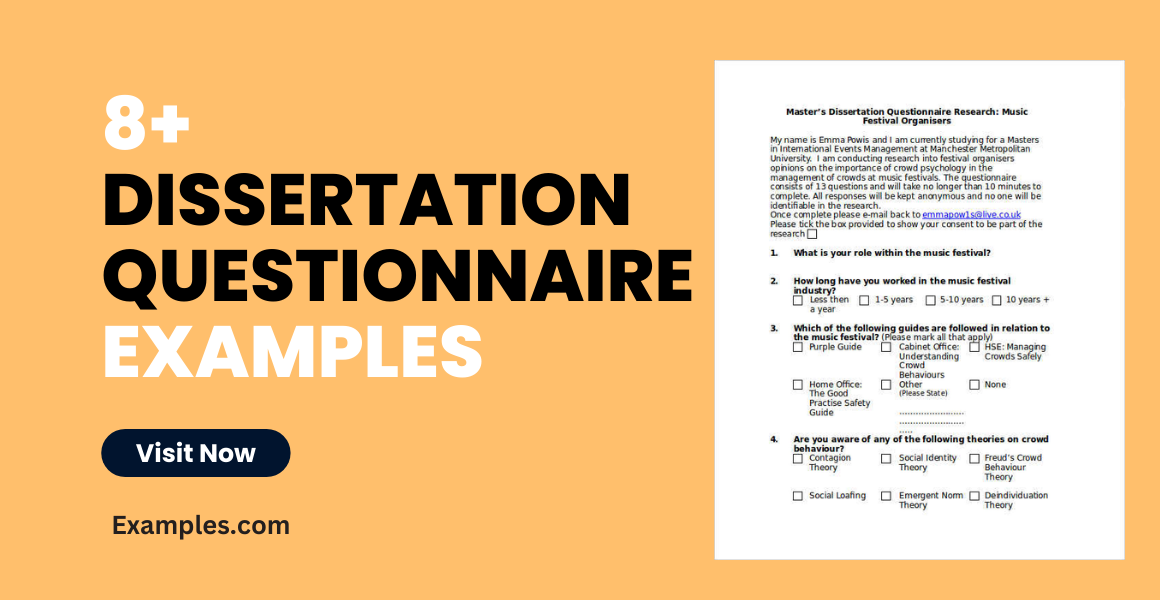
A dissertation is a document usually a requirement for a doctoral degree especially in the field of philosophy. This long essay discusses a particular subject matter uses questionnaires and other sources of data and is used to validate its content. The questionnaire’s importance is evident in the processes of data gathering as it can make the dissertation factual, effective and usable.
Having a well-curated and formatted document to follow when making a dissertation can be very beneficial to an individual who is currently immersed in the data gathering stage of the specific research study. We have gathered downloadable samples and templates of questionnaires so it will be easier for you to curate your own.
Dissertation Timeline Gantt Chart Template
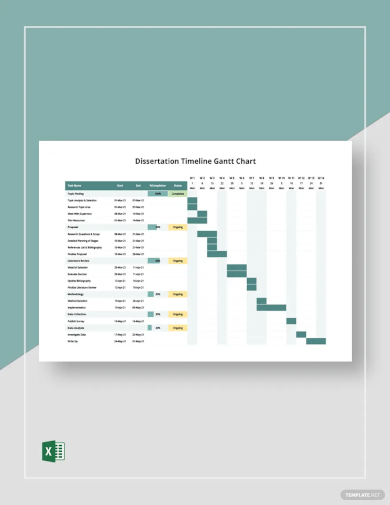
Size: 55 KB
Dissertation Research Gantt Chart Template
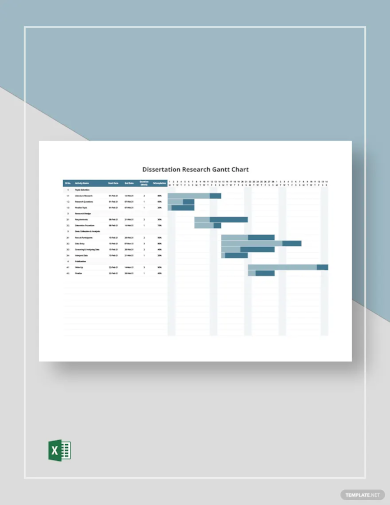
Size: 43 KB
Dissertation Project Gantt Chart Template
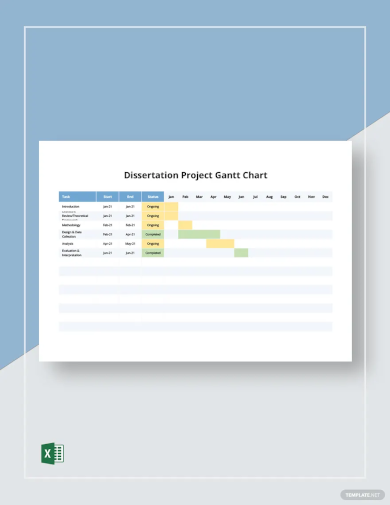
Size: 41 KB
Dissertation Plan Gantt Chart Template
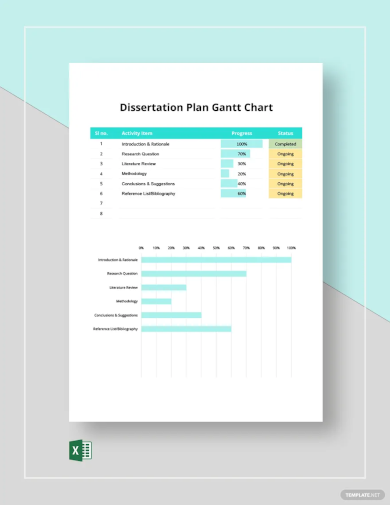
Size: 51 KB
Dissertation Research Questionnaire
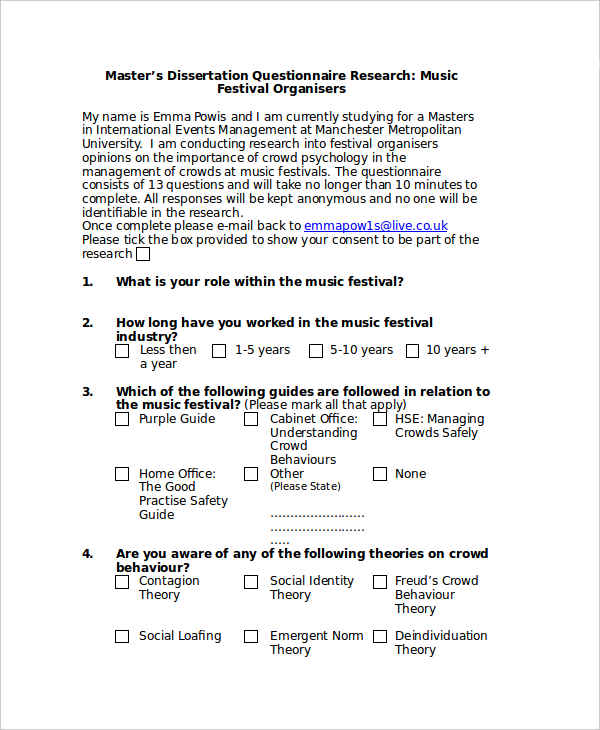
Size: 18 KB
Dissertation Proposal Questionnaire
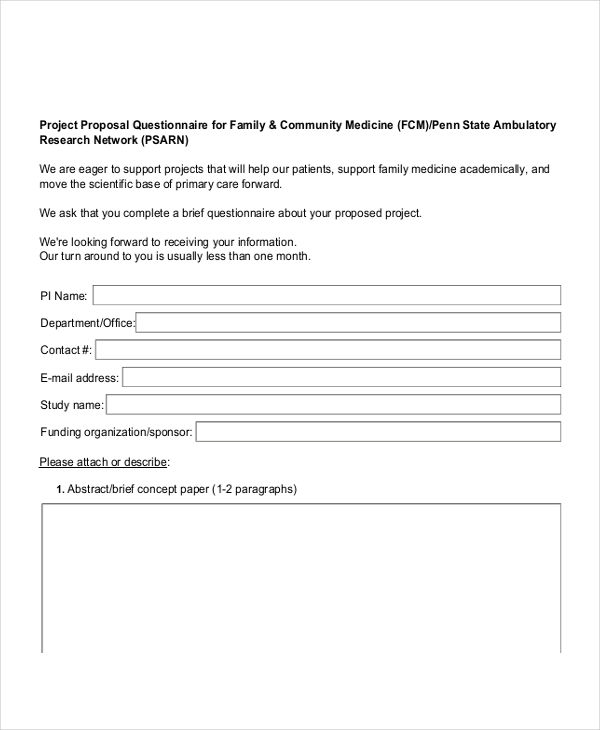
Size: 131 KB
Sample Dissertation Questionnaire
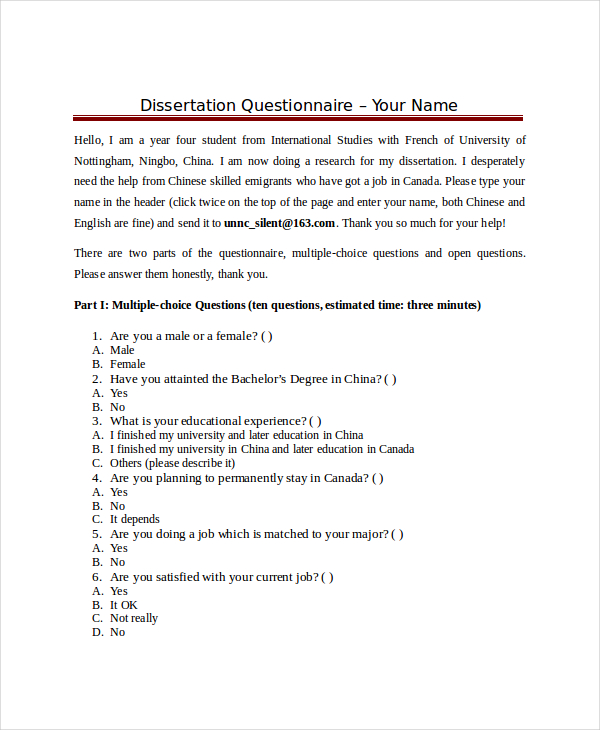
Size: 10 KB
What Is a Dissertation Questionnaire?
A dissertation questionnaire can be defined as follows:
- It is a document used in the processes of data gathering.
- Questionnaires in PDF used for a dissertation contain questions that can help assess the current condition of the community which is the subject of study within the dissertation.
- It specifies the questions that are needed to be answered to assure that there is a basis in terms of the results that will be presented in a dissertation.
How to Write a Dissertation Questionnaire
Writing an efficient and comprehensive dissertation questionnaire can greatly affect the entire dissertation. You can make one by following these steps:
- Be specific with the kind of dissertation that you are creating and align the purposes of the dissertation questionnaire that you need to make to your study.
- List down the information needed from the community who will provide the answers to your questions.
- Open a software where you can create a questionnaire template. You may also download survey questionnaire examples and templates to have a faster time in formatting the document.
- The purpose of the dissertation questionnaire.
- The guidelines and instructions in answering the dissertation questions.
- The name of the person to who will use the questionnaire results to his/her dissertation.
- The institution to whom the dissertation will be passed.
- List down the questions based on your needs.
Undergraduate Dissertation Questionnaire
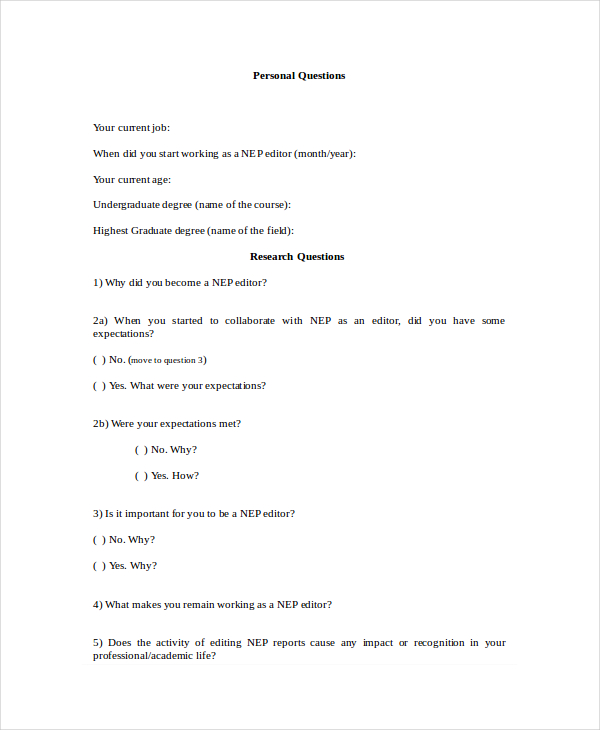
Size: 12 KB
Project Management Dissertation

Size: 54 KB
Guidelines for Writing a Dissertation Questionnaire
There are no strict rules in writing a dissertation questionnaire. However, there are some tips that can help you to create a dissertation questionnaire that is relevant to the study that you are currently doing. Some guidelines:
- Make sure that you are well aware of the data that is needed in your dissertation so you can properly curate questions that can supply your information needs.
- It will be best to use a dissertation questionnaire format that is organized, easy to understand, and properly structured. This will help the people who will answer the dissertation questionnaire quickly know how they can provide the items that you would like to know.
- Always make sure that your instructions in answering the questions are precise and directly stated.
- You may look at questionnaires in Word for comparisons. Doing this will help you assess whether there are still areas of improvement that you may tap with the content and format of the dissertation questionnaire that you have created.
Keeping this guidelines in mind and implementing them accordingly will allow you to create a dissertation questionnaire that is beneficial to the processes that you need to have an outstanding dissertation.
Questionnaire Generator
Text prompt
- Instructive
- Professional
Create a fun quiz to find out which historical figure you're most like in your study habits
Design a survey to discover students' favorite school subjects and why they love them.
Have a language expert improve your writing
Run a free plagiarism check in 10 minutes, automatically generate references for free.
- Knowledge Base
- Methodology
- Questionnaire Design | Methods, Question Types & Examples
Questionnaire Design | Methods, Question Types & Examples
Published on 6 May 2022 by Pritha Bhandari . Revised on 10 October 2022.
A questionnaire is a list of questions or items used to gather data from respondents about their attitudes, experiences, or opinions. Questionnaires can be used to collect quantitative and/or qualitative information.
Questionnaires are commonly used in market research as well as in the social and health sciences. For example, a company may ask for feedback about a recent customer service experience, or psychology researchers may investigate health risk perceptions using questionnaires.
Table of contents
Questionnaires vs surveys, questionnaire methods, open-ended vs closed-ended questions, question wording, question order, step-by-step guide to design, frequently asked questions about questionnaire design.
A survey is a research method where you collect and analyse data from a group of people. A questionnaire is a specific tool or instrument for collecting the data.
Designing a questionnaire means creating valid and reliable questions that address your research objectives, placing them in a useful order, and selecting an appropriate method for administration.
But designing a questionnaire is only one component of survey research. Survey research also involves defining the population you’re interested in, choosing an appropriate sampling method , administering questionnaires, data cleaning and analysis, and interpretation.
Sampling is important in survey research because you’ll often aim to generalise your results to the population. Gather data from a sample that represents the range of views in the population for externally valid results. There will always be some differences between the population and the sample, but minimising these will help you avoid sampling bias .
Prevent plagiarism, run a free check.
Questionnaires can be self-administered or researcher-administered . Self-administered questionnaires are more common because they are easy to implement and inexpensive, but researcher-administered questionnaires allow deeper insights.
Self-administered questionnaires
Self-administered questionnaires can be delivered online or in paper-and-pen formats, in person or by post. All questions are standardised so that all respondents receive the same questions with identical wording.
Self-administered questionnaires can be:
- Cost-effective
- Easy to administer for small and large groups
- Anonymous and suitable for sensitive topics
But they may also be:
- Unsuitable for people with limited literacy or verbal skills
- Susceptible to a nonreponse bias (most people invited may not complete the questionnaire)
- Biased towards people who volunteer because impersonal survey requests often go ignored
Researcher-administered questionnaires
Researcher-administered questionnaires are interviews that take place by phone, in person, or online between researchers and respondents.
Researcher-administered questionnaires can:
- Help you ensure the respondents are representative of your target audience
- Allow clarifications of ambiguous or unclear questions and answers
- Have high response rates because it’s harder to refuse an interview when personal attention is given to respondents
But researcher-administered questionnaires can be limiting in terms of resources. They are:
- Costly and time-consuming to perform
- More difficult to analyse if you have qualitative responses
- Likely to contain experimenter bias or demand characteristics
- Likely to encourage social desirability bias in responses because of a lack of anonymity
Your questionnaire can include open-ended or closed-ended questions, or a combination of both.
Using closed-ended questions limits your responses, while open-ended questions enable a broad range of answers. You’ll need to balance these considerations with your available time and resources.
Closed-ended questions
Closed-ended, or restricted-choice, questions offer respondents a fixed set of choices to select from. Closed-ended questions are best for collecting data on categorical or quantitative variables.
Categorical variables can be nominal or ordinal. Quantitative variables can be interval or ratio. Understanding the type of variable and level of measurement means you can perform appropriate statistical analyses for generalisable results.
Examples of closed-ended questions for different variables
Nominal variables include categories that can’t be ranked, such as race or ethnicity. This includes binary or dichotomous categories.
It’s best to include categories that cover all possible answers and are mutually exclusive. There should be no overlap between response items.
In binary or dichotomous questions, you’ll give respondents only two options to choose from.
White Black or African American American Indian or Alaska Native Asian Native Hawaiian or Other Pacific Islander
Ordinal variables include categories that can be ranked. Consider how wide or narrow a range you’ll include in your response items, and their relevance to your respondents.
Likert-type questions collect ordinal data using rating scales with five or seven points.
When you have four or more Likert-type questions, you can treat the composite data as quantitative data on an interval scale . Intelligence tests, psychological scales, and personality inventories use multiple Likert-type questions to collect interval data.
With interval or ratio data, you can apply strong statistical hypothesis tests to address your research aims.
Pros and cons of closed-ended questions
Well-designed closed-ended questions are easy to understand and can be answered quickly. However, you might still miss important answers that are relevant to respondents. An incomplete set of response items may force some respondents to pick the closest alternative to their true answer. These types of questions may also miss out on valuable detail.
To solve these problems, you can make questions partially closed-ended, and include an open-ended option where respondents can fill in their own answer.
Open-ended questions
Open-ended, or long-form, questions allow respondents to give answers in their own words. Because there are no restrictions on their choices, respondents can answer in ways that researchers may not have otherwise considered. For example, respondents may want to answer ‘multiracial’ for the question on race rather than selecting from a restricted list.
- How do you feel about open science?
- How would you describe your personality?
- In your opinion, what is the biggest obstacle to productivity in remote work?
Open-ended questions have a few downsides.
They require more time and effort from respondents, which may deter them from completing the questionnaire.
For researchers, understanding and summarising responses to these questions can take a lot of time and resources. You’ll need to develop a systematic coding scheme to categorise answers, and you may also need to involve other researchers in data analysis for high reliability .
Question wording can influence your respondents’ answers, especially if the language is unclear, ambiguous, or biased. Good questions need to be understood by all respondents in the same way ( reliable ) and measure exactly what you’re interested in ( valid ).
Use clear language
You should design questions with your target audience in mind. Consider their familiarity with your questionnaire topics and language and tailor your questions to them.
For readability and clarity, avoid jargon or overly complex language. Don’t use double negatives because they can be harder to understand.
Use balanced framing
Respondents often answer in different ways depending on the question framing. Positive frames are interpreted as more neutral than negative frames and may encourage more socially desirable answers.
Use a mix of both positive and negative frames to avoid bias , and ensure that your question wording is balanced wherever possible.
Unbalanced questions focus on only one side of an argument. Respondents may be less likely to oppose the question if it is framed in a particular direction. It’s best practice to provide a counterargument within the question as well.
Avoid leading questions
Leading questions guide respondents towards answering in specific ways, even if that’s not how they truly feel, by explicitly or implicitly providing them with extra information.
It’s best to keep your questions short and specific to your topic of interest.
- The average daily work commute in the US takes 54.2 minutes and costs $29 per day. Since 2020, working from home has saved many employees time and money. Do you favour flexible work-from-home policies even after it’s safe to return to offices?
- Experts agree that a well-balanced diet provides sufficient vitamins and minerals, and multivitamins and supplements are not necessary or effective. Do you agree or disagree that multivitamins are helpful for balanced nutrition?
Keep your questions focused
Ask about only one idea at a time and avoid double-barrelled questions. Double-barrelled questions ask about more than one item at a time, which can confuse respondents.
This question could be difficult to answer for respondents who feel strongly about the right to clean drinking water but not high-speed internet. They might only answer about the topic they feel passionate about or provide a neutral answer instead – but neither of these options capture their true answers.
Instead, you should ask two separate questions to gauge respondents’ opinions.
Strongly Agree Agree Undecided Disagree Strongly Disagree
Do you agree or disagree that the government should be responsible for providing high-speed internet to everyone?
You can organise the questions logically, with a clear progression from simple to complex. Alternatively, you can randomise the question order between respondents.
Logical flow
Using a logical flow to your question order means starting with simple questions, such as behavioural or opinion questions, and ending with more complex, sensitive, or controversial questions.
The question order that you use can significantly affect the responses by priming them in specific directions. Question order effects, or context effects, occur when earlier questions influence the responses to later questions, reducing the validity of your questionnaire.
While demographic questions are usually unaffected by order effects, questions about opinions and attitudes are more susceptible to them.
- How knowledgeable are you about Joe Biden’s executive orders in his first 100 days?
- Are you satisfied or dissatisfied with the way Joe Biden is managing the economy?
- Do you approve or disapprove of the way Joe Biden is handling his job as president?
It’s important to minimise order effects because they can be a source of systematic error or bias in your study.
Randomisation
Randomisation involves presenting individual respondents with the same questionnaire but with different question orders.
When you use randomisation, order effects will be minimised in your dataset. But a randomised order may also make it harder for respondents to process your questionnaire. Some questions may need more cognitive effort, while others are easier to answer, so a random order could require more time or mental capacity for respondents to switch between questions.
Follow this step-by-step guide to design your questionnaire.
Step 1: Define your goals and objectives
The first step of designing a questionnaire is determining your aims.
- What topics or experiences are you studying?
- What specifically do you want to find out?
- Is a self-report questionnaire an appropriate tool for investigating this topic?
Once you’ve specified your research aims, you can operationalise your variables of interest into questionnaire items. Operationalising concepts means turning them from abstract ideas into concrete measurements. Every question needs to address a defined need and have a clear purpose.
Step 2: Use questions that are suitable for your sample
Create appropriate questions by taking the perspective of your respondents. Consider their language proficiency and available time and energy when designing your questionnaire.
- Are the respondents familiar with the language and terms used in your questions?
- Would any of the questions insult, confuse, or embarrass them?
- Do the response items for any closed-ended questions capture all possible answers?
- Are the response items mutually exclusive?
- Do the respondents have time to respond to open-ended questions?
Consider all possible options for responses to closed-ended questions. From a respondent’s perspective, a lack of response options reflecting their point of view or true answer may make them feel alienated or excluded. In turn, they’ll become disengaged or inattentive to the rest of the questionnaire.
Step 3: Decide on your questionnaire length and question order
Once you have your questions, make sure that the length and order of your questions are appropriate for your sample.
If respondents are not being incentivised or compensated, keep your questionnaire short and easy to answer. Otherwise, your sample may be biased with only highly motivated respondents completing the questionnaire.
Decide on your question order based on your aims and resources. Use a logical flow if your respondents have limited time or if you cannot randomise questions. Randomising questions helps you avoid bias, but it can take more complex statistical analysis to interpret your data.
Step 4: Pretest your questionnaire
When you have a complete list of questions, you’ll need to pretest it to make sure what you’re asking is always clear and unambiguous. Pretesting helps you catch any errors or points of confusion before performing your study.
Ask friends, classmates, or members of your target audience to complete your questionnaire using the same method you’ll use for your research. Find out if any questions were particularly difficult to answer or if the directions were unclear or inconsistent, and make changes as necessary.
If you have the resources, running a pilot study will help you test the validity and reliability of your questionnaire. A pilot study is a practice run of the full study, and it includes sampling, data collection , and analysis.
You can find out whether your procedures are unfeasible or susceptible to bias and make changes in time, but you can’t test a hypothesis with this type of study because it’s usually statistically underpowered .
A questionnaire is a data collection tool or instrument, while a survey is an overarching research method that involves collecting and analysing data from people using questionnaires.
Closed-ended, or restricted-choice, questions offer respondents a fixed set of choices to select from. These questions are easier to answer quickly.
Open-ended or long-form questions allow respondents to answer in their own words. Because there are no restrictions on their choices, respondents can answer in ways that researchers may not have otherwise considered.
A Likert scale is a rating scale that quantitatively assesses opinions, attitudes, or behaviours. It is made up of four or more questions that measure a single attitude or trait when response scores are combined.
To use a Likert scale in a survey , you present participants with Likert-type questions or statements, and a continuum of items, usually with five or seven possible responses, to capture their degree of agreement.
You can organise the questions logically, with a clear progression from simple to complex, or randomly between respondents. A logical flow helps respondents process the questionnaire easier and quicker, but it may lead to bias. Randomisation can minimise the bias from order effects.
Questionnaires can be self-administered or researcher-administered.
Researcher-administered questionnaires are interviews that take place by phone, in person, or online between researchers and respondents. You can gain deeper insights by clarifying questions for respondents or asking follow-up questions.
Cite this Scribbr article
If you want to cite this source, you can copy and paste the citation or click the ‘Cite this Scribbr article’ button to automatically add the citation to our free Reference Generator.
Bhandari, P. (2022, October 10). Questionnaire Design | Methods, Question Types & Examples. Scribbr. Retrieved 21 May 2024, from https://www.scribbr.co.uk/research-methods/questionnaire-design/
Is this article helpful?

Pritha Bhandari
Other students also liked, doing survey research | a step-by-step guide & examples, what is a likert scale | guide & examples, reliability vs validity in research | differences, types & examples.

Dissertation Format and Submission
- Format Guidelines
- Dissertation Submission
- Getting Survey Permissions
- Help Videos
Instrument Permission documents
Instrument Permissions FAQ
Download a pdf of this faq , download the template permission letter, permissions to use and reproduce instruments in a thesis/dissertation frequently asked questions, why might i need permission to use an instrument in my thesis/dissertation.
- Determine whether you need permission
- Identify the copyright holder
- Ask for permission
- Keep a record
- What if I can't locate the copyright holder?
If you want to use surveys, questionnaires, interview questions, tests, measures, or other instruments created by other people, you are required to locate and follow usage permissions. The instrument may be protected by copyright and/or licensing restrictions.
Copyright Protection
Copyright provides authors of original creative work with limited control over the reproduction and distribution of that work. Under United States law, all original expressions that are “fixed in a tangible medium” are automatically protected by copyright at the time of their creation. In other words, it is not necessary to formally state a declaration of copyright, to use the © symbol, or to register with the United States Copyright Office.
Therefore, you must assume that any material you find is copyrighted, unless you have evidence otherwise. This is the case whether you find the instrument openly on the web, in a library database, or reproduced in a journal article. It is your legal and ethical responsibility to obtain permission to use, modify, and/or reproduce the instrument.
If you use and/or reproduce material in your thesis/dissertation beyond the limits outlined by the “fair use” doctrine, which allows for limited use of a work, without first gaining the copyright holder’s permission, you may be infringing copyright.
Licensing/Terms of Use
Some instruments are explicitly distributed under a license agreement or terms of use. Unlike copyright, which applies automatically, users must agree to these terms in order to use the instrument. In exchange for abiding by the terms, the copyright holder grants the licensee specific and limited rights, such as the right to use the instrument in scholarly research, or to reproduce the instrument in a publication.
When you ask a copyright holder for permission to use or reproduce an instrument, you are in effect asking for a license to do those things.
How do I know if I need permission to use instruments in my thesis/dissertation research? (Adapted from Hathcock & Crews )
Follow the four-step process below:
1. Determine whether you need permission
There are different levels of permissions for using an instrument:
a) No permission required
i. The copyright holder has explicitly licensed the use of instrument for any purpose, without requiring you to obtain permission.
ii. If you are only using a limited portion of the instrument, your use may be covered under the Fair Use Doctrine. See more here: https://uhcl.libguides.com/copyright/fairuse .
iii. If the instrument was developed by the federal government or under a government grant it may be in the public domain, and permission is therefore not required.
iv. If the document was created before 1977, it may be in the public domain, and permission is therefore not required. See the Stanford Public Domain Flowchart at https://fairuse.stanford.edu/wp-content/uploads/2014/06/publicdomainflowchart.png .
b) Non-commercial/educational use: The copyright holder has licensed the instrument only for non-commercial research or educational purposes, without requiring you to obtain the permission of the copyright holder. Any other usage requires permission.
Sample Permission for Educational Use:
Test content may be reproduced and used for non-commercial research and educational purposes without seeking written permission. Distribution must be controlled, meaning only to the participants engaged in the research or enrolled in the educational activity. Any other type of reproduction or distribution of test content is not authorized without written permission from the author and publisher. Always include a credit line that contains the source citation and copyright owner when writing about or using any test.
Source: Marta Soto, “How Permissions Work in PsycTests,” APA Databases & Electronic Resources Blog. American Psychological Association. http://blog.apapubs.org/2016/12/21/how-permissions-work-in-psyctests/ .
Even if you are not required to obtain permission to use the instrument, consider contacting the author for ideas on how to administer and analyze the test. Authors often welcome further use of their work, and may request you send them a copy of your final work.
c) Permission required: Instruments that require you to obtain the permission of the copyright holder, regardless of whether the use is for educational or commercial purposes. This may be because the copyright holder
- has important directions for how the test must be administered and analyzed
- wants to make sure the most current version is being used
- charges users a fee in order to administer the test
If you cannot locate the permissions, you are required to identify the copyright holder and contact them to ask about permission to use the instrument.
2. Identify the copyright holder (Adapted from Crews )
The next step is to identify who owns the copyright. The copyright holder is usually the creator of the work. If the copyright owner is an individual, you will need to do the usual Internet and telephone searches to find the person. Be ready to introduce yourself and to explain carefully what you are seeking.
Some authors transfer copyright to another entity, such as a journal publisher or an organization. In these cases, you must obtain permission from that entity to use or reproduce the instrument. You can often identify the owner by locating a © copyright notice, but as mentioned above, not all copyrighted works have a notice.
Check the following sources to locate instruments, their copyright holders, and their permission statements:
- Mental Measurements Yearbook: https://uhcl.idm.oclc.org/login?url=https://search.ebscohost.com/login.aspx?authtype=ip,uid&profile=ehost&defaultdb=mmt
- PsycTESTS: https://uhcl.idm.oclc.org/login?url=https://search.ebscohost.com/login.aspx?authtype=ip,uid&profile=ehost&defaultdb=pst
- Neumann Library Tests & Measures help: https://uhcl.libguides.com/PSYC/tests
- Library assistance e-mail: [email protected]
You may need to contact the author or publisher directly to find out who owns the copyright. Publishers often have websites that prescribe a method for contacting the copyright owner, so search the publisher website for a permissions department or contact person. Be sure to confirm the exact name and address of the addressee, and call/e-mail the person or publishing house to confirm the copyright ownership.
- The copyright owner may prefer or require that permission requests be made using a certain medium (i.e. fax, mail, web form, etc.). If you do not follow instructions, you may not get a reply.
- Telephone calls may be the quickest method for getting a response from the owner, but they should be followed up with a letter or e-mail in order to document the exact scope of the permission. E-mail permissions are legally acceptable in most cases, but getting a genuine signature is usually best.
- The request should be sent to the individual copyright holder (when applicable) or permissions department of the publisher in question. Be sure to include your return address, telephone and fax numbers, e-mail address, and the date at the top of your letter or message. If you send the permission request by mail, include a self-addressed, stamped return envelope.
- Make the process easy for the copyright owner. The less effort the owner has to put forth, the more likely you will get the permission you need. If you are using conventional mail, include a second copy of your request for the owner’s records.
- State clearly who you are, your institutional affiliation (e.g., University of Houston-Clear Lake), and the general nature of your thesis/dissertation research.
Do not send permissions letters to all possible rightsholders simultaneously. Taking the time to find the person who most likely holds the copyright will better yield success. If you do not have much information about who actually owns the copyright, be honest with your contacts, and they may be able to help you find the right person.
3. Ask for permission (Adapted from Crews )
Once you have identified the copyright holder, you must determine the scope of your permission request. Some copyright owners furnish their own permission form that you may download from their website.
If the copyright owner does not provide a permission agreement form, you may write your own letter ( click here to download a template ). Requests should be made in writing; e-mail is fine for this purpose. A most effective letter will include detailed information concerning your request for permission to use the work. Include the following information:
- Who: Introduce yourself. Tell who you are, your degree program, and a brief overview of your research.
- Why: Tell why you are contacting that person or entity for permission.
- What: Be as specific as possible when you cite and describe the instrument you wish to use. Include whether you plan to use the entire instrument, or if you plan on modifying or adapting any of the questions.
- How: Tell how you plan to use the instrument. Specify the parameters of your research study, and include any important information about the way you will administer the instrument and/or analyze the results.
- When: Expected length of the project and time to complete the thesis/dissertation.
Important : Obtaining permission to use an instrument is not the same as obtaining permission to reproduce the instrument in your appendix. If you intend on providing a copy of the instrument in an appendix, ask for separate permissions to do that.
Click here to download a template letter . Feel free to modify and adapt this template for your purposes.
4. Keep a record
After securing permission to use and/or reproduce the instrument, save a copy of the correspondence and the agreement. Documentation allows you to demonstrate to others that you have the legal right to use the owner's work. In the unlikely event that your use of the work is ever challenged, you will need to demonstrate your good faith efforts. That challenge could arise far in the future, so keep a permanent file of the records. Moreover, you might need to contact that same copyright owner again for a later use of the work, and your notes from the past will make the task easier.
Upload a copy of your permission letter in Vireo with your thesis/dissertation, or include it as an appendix in the document itself.
What if I can't locate the copyright holder? (Adapted from Hathcock & Crews & Pantalony )
In some cases, you may never get a response from the copyright holder or you may never even be able to identify who they are or how to contact them. It can be difficult to know how to proceed when you reach a dead end. Unfortunately, no matter how diligently you have tried to get permission, these efforts cannot completely eliminate the risk of infringement should you proceed to use the work.
Assuming you have diligently investigated your alternatives, do not want to change your project, and remain in need of the elusive copyright permission, the remaining alternative is to explore a risk-benefit analysis. You need to balance the benefits of using that particular material in your given project against the risks that a copyright owner may see your project, identify the materials, and assert the owner’s legal claims against you. Numerous factual circumstances may be important in this evaluation. The “benefit” may depend upon the importance of your project and the importance of using that particular material. The “risks” may depend upon whether your project will be published or available on the Internet for widespread access—as theses and dissertations will. You ought to investigate whether the work is registered with the U.S. Copyright Office and weigh the thoroughness of your search for the copyright owner and your quest for appropriate permission.
Undertaking this analysis can be sensitive and must be advanced with caution and with careful documentation. You may be acting to reduce the risk of liability, but you have not eliminated liability. A copyright owner may still hold rights to the material. Members of the University of Houston-Clear Lake community should consult with their chair or the Neumann Library to discuss their options.
Portions of this FAQ are used and adapted from:
Crews, Kenneth and Rina Elster Pantalony. “Special Cases.” Columbia University Copyright Advisory Services. https://copyright.columbia.edu/basics/special-cases.html . Licensed under Creative Commons Attribution 4.0 International (CC BY 4.0).
Crews, Kenneth. “Asking for Permission.” Columbia University Advisory Services. https://copyright.columbia.edu/basics/permissions-and-licensing.html . Licensed under Creative Commons Attribution 4.0 International (CC BY 4.0).
Hathcock, April. “Getting Permission.” NYU Libraries Copyright Library Guide, https://guides.nyu.edu/c.php?g=276785&p=1845968 . Licensed under Creative Commons Attribution-NonCommercial 4.0 International (CC BY-NC 4.0).
- << Previous: Dissertation Submission
- Next: Help Videos >>
- Last Updated: May 21, 2024 2:16 PM
- URL: https://uhcl.libguides.com/dissertation

Berkeley EECS
Welcome to the Department of Electrical Engineering and Computer Sciences at UC Berkeley. Our top-ranked programs attract stellar students and professors from around the world, who pioneer the frontiers of information science and technology with broad impact on society. Underlying our success are a strong tradition of collaboration, close ties to industry, and a supportive culture. Explore our vibrant and dynamic community through this website or in person.
What's Happening

CDSS celebrates students’ resilience at inaugural college graduation

Irene Chen and Preeya Khanna win Google Research Scholar Awards

5 questions for UC Berkeley’s Ben Recht

Newly elected members to the American Academy of Arts and Sciences include EECS faculty, alumni

EECS Professor Sayeef Salahuddin and alumnus Kevin Kornegay elected lifetime fellows of the American Association for the Advancement of Science

Francisca Vasconcelos chosen as Paul and Daisy Soros New American fellow

AI Language Models Allow Researchers to Explore New Frontiers in Bioengineering

How to keep AI from killing us all

An OpenAI spinoff has built an AI model that helps robots learn tasks like humans

EECS graduate students recognized for outstanding peer mentorship

Anca Dragan named Head of AI Safety and Alignment at Google DeepMind

CS alumnus gifts 1M to Berkeley EECS

We offer one of the most comprehensive research and instructional programs in this field anywhere in the world.
- Graduate Admissions and Programs
- Undergraduate Admissions and Programs

The research developed here is part of a tradition of outstanding scholarship and visionary innovation.
- Centers and Labs
- Technical Reports

Our faculty, students, staff and alumni are central to our success as one of the most thriving and distinguished departments on the Berkeley campus.
- EECS Directory
Upcoming Events
Virtual tech talk w/ apple - how custom silicon made apple vision pro possible.
Tuesday May 21, 2024
9:30 AM – 11:00 AM
Register to receive WebEx link

EECS Joint Colloquium
The weekly EECS Colloquium offers our faculty a chance to invite speakers offering a wide range of experiences covering topics in both Electrical Engineering and Computer Science to engage with the department.

The Joseph Thomas Gier Memorial Dedication Ceremony
We invite you to recognize the profound contributions of Professor Joseph Thomas Gier to the University of California, the first tenured Black professor in the UC system. Sculptor Dana King unveiled a bronze statue in honor of Gier in the Blum Hall courtyard.
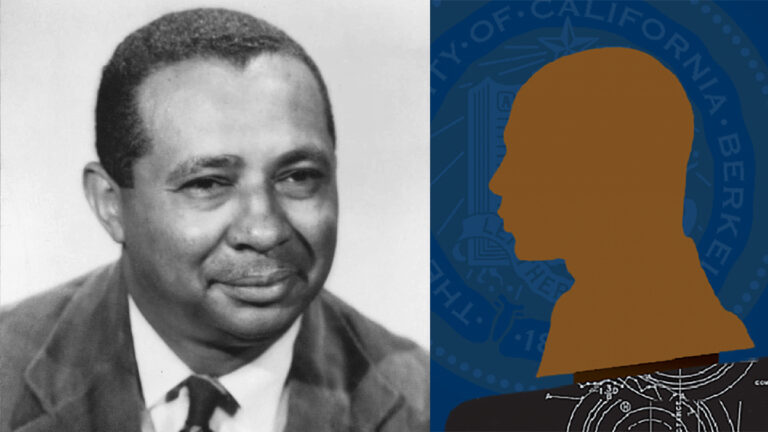
Support the Gier Memorial Project
A community is defined by the heroes it chooses to celebrate. We invite you to join the EECS department in recognizing a previously overlooked hero, Berkeley EE Prof. Joseph T. Gier, the University of California’s first tenured Black professor.

IMAGES
VIDEO
COMMENTS
Dissertation survey examples. Whatever field you're studying, we're sure the following questions will prove useful when crafting your own. At the beginning of every questionnaire, inform respondents of your topic and provide a consent form. After that, start with questions like:
Surveys are a powerful way to collect data for your dissertation, thesis or research project. Done right, a good survey allows you to collect large swathes of useful data with (relatively) little effort. However, if not designed well, you can run into serious issues.. Over the years, we've encountered numerous common mistakes students make when it comes to survey design.
Survey research means collecting information about a group of people by asking them questions and analysing the results. To conduct an effective survey, follow these six steps: Determine who will participate in the survey. Decide the type of survey (mail, online, or in-person) Design the survey questions and layout. Distribute the survey.
Questionnaires vs. surveys. A survey is a research method where you collect and analyze data from a group of people. A questionnaire is a specific tool or instrument for collecting the data.. Designing a questionnaire means creating valid and reliable questions that address your research objectives, placing them in a useful order, and selecting an appropriate method for administration.
Survey research means collecting information about a group of people by asking them questions and analyzing the results. To conduct an effective survey, follow these six steps: Determine who will participate in the survey. Decide the type of survey (mail, online, or in-person) Design the survey questions and layout.
Surveys are a special research tool with strengths, weaknesses, and a language all of their own. There are many different steps to designing and conducting a survey, and survey researchers have specific ways of describing what they do.This handout, based on an annual workshop offered by the Program on Survey Research at Harvard, is geared toward undergraduate honors thesis writers using survey ...
Questionnaire surveys are a well-established way of collecting data. They work with relatively small-scale research projects so design and deliver research questionnaires quickly and cheaply. When it comes to conducting research for a master's dissertation, questionnaire surveys feature prominently as the method of choice.
Learn about the 5 most common mistakes researchers make when designing a survey for a dissertation, thesis or research project. David Phair (PhD) and Kerryn ...
Prof Martyn Denscombe, author of "The Good Research Guide, 6th edition", gives expert advice on using a questionnaire survey for your postgraduate dissertation. Questionnaire surveys are a well-established way of collecting data. They can be used with relatively small-scale research projects, and research questionnaires can be designed and delivered quite quickly and cheaply.
Questionnaire Design Tip Sheet. This PSR Tip Sheet provides some basic tips about how to write good survey questions and design a good survey questionnaire. PSR Questionnaire Tip Sheet. 40 KB. Printer-friendly version.
A questionnaire is an important instrument in a research study to help the researcher collect relevant data regarding the research topic. It is significant to ensure that the design of the ...
Effective survey questions and responses take careful construction by researchers, as participants may be confused or otherwise influenced by how items are phrased. The questionnaire should start with informed consent and instructions, flow logically from one topic to the next, engage but not shock participants, and thank participants at the ...
A good research question is essential to guide your research paper, dissertation, or thesis. All research questions should be: Focused on a single problem or issue. Researchable using primary and/or secondary sources. Feasible to answer within the timeframe and practical constraints. Specific enough to answer thoroughly.
Surveys for dissertation. by Jakub Wierusz. 17 Mar 2024. survey academy TIPS. We are starting a series of articles created for students who are looking for an online survey and questionnaire tool for their dissertations. While planning your survey you can select from multiple research techniques. Each one can be the subject of a separate article.
Qualitative surveys aim to elicit a detailed response to an open-ended topic question in the participant's own words. Like quantitative surveys, there are three main methods for using qualitative surveys including face to face surveys, phone surveys, and online surveys. Each method of surveying has strengths and limitations. Face to face surveys.
First-Hand Experience. The ability to gain a unique perspective is what distinguishes interviews from other surveys. Close-ended questions may be too rigid and make participants omit a lot of information that might help the research. In an interview, you may also correct some of your questions, and add more details to them, thus improving the ...
Join a dissertation survey exchange group on Facebook. Another quick way to find people online who can take your dissertation survey is via Facebook and other social media networks. There are several pre-existing groups on Facebook ( such as this one) which allow students to exchange survey links. You'll have to take other people's surveys ...
Students, faculty, and professionals conduct academic surveys as part of their research projects. An academic survey is a tool designed to obtain more knowledge and data about a chosen subject. The results are used to answer questions or confirm hypotheses posed by the researchers. Surveys results can then be the basis of your research report ...
A dissertation is a document usually a requirement for a doctoral degree especially in the field of philosophy. This long essay discusses a particular subject matter uses questionnaires and other sources of data and is used to validate its content. The questionnaire's importance is evident in the processes of data gathering as it can make the dissertation factual, effective and usable.
Questionnaires vs surveys. A survey is a research method where you collect and analyse data from a group of people. A questionnaire is a specific tool or instrument for collecting the data.. Designing a questionnaire means creating valid and reliable questions that address your research objectives, placing them in a useful order, and selecting an appropriate method for administration.
students doing dissertation projects, and this may be for the following reasons. ... The most common method used in social and management sciences is the survey questionnaire because it is a cost ...
Boost response rates with skip-logic, piping and custom variables. Collect data with a secure, compliant and anonymous platform. SmartSurvey offers the survey solution you need to conduct an effective dissertation survey. Bag first class results and nail your research projects with the power of SmartSurvey. All for less than the price of a pizza!
If you want to use surveys, questionnaires, interview questions, tests, measures, or other instruments created by other people, you are required to locate and follow usage permissions. ... How do I know if I need permission to use instruments in my thesis/dissertation research? (Adapted from Hathcock & Crews) Follow the four-step process below ...
Welcome to the Department of Electrical Engineering and Computer Sciences at UC Berkeley. Our top-ranked programs attract stellar students and professors from around the world, who pioneer the frontiers of information science and technology with broad impact on society. Underlying our success are a strong tradition of collaboration, close ties ...